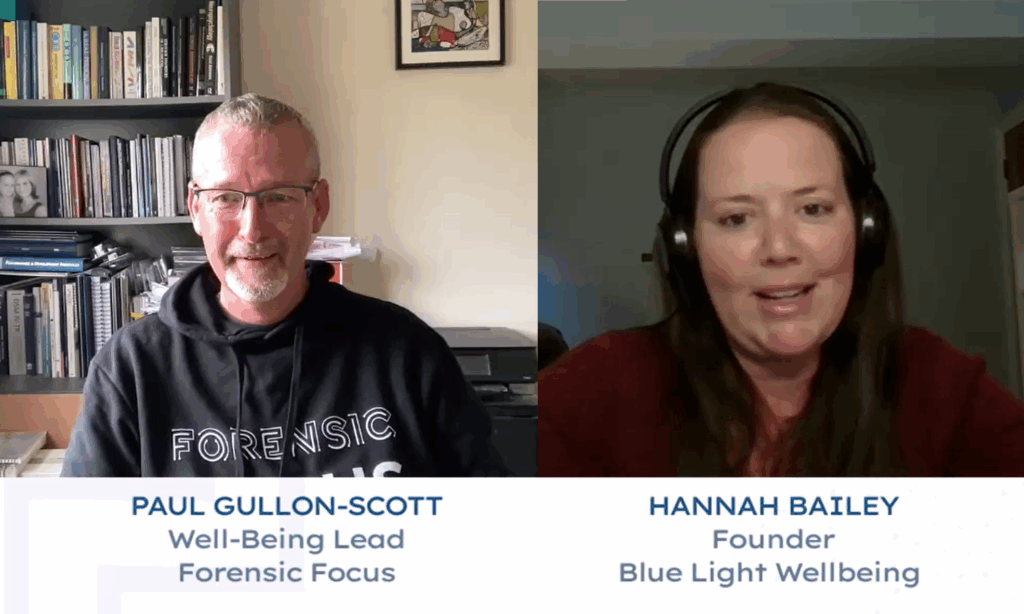
Discover how tailored, culturally aware mental health support can help digital forensic investigators cope with the hidden trauma of their work.
by Debbie Garner, a retired law enforcement executive, technology advocate across the private and non-profit sectors, and Community Engagement Coordinator for Hexordia
Recent articles, blogs, and social media posts have raised concerns that, in many agencies and organizations, digital forensics is devolving into mere “button pushing,” with many of these so-called “button pushers” trained only to a basic level or familiar with a specific tool, without fully understanding how the tool works or how to explain its findings. This concerning trend is rooted in a multifaceted array of challenges, including significant budgetary constraints, a persistent lack of adequate personnel, and a pervasive scarcity of comprehensive training or the necessary funding to provide it. Furthermore, the desire for a one-stop-shop solution often overshadows the need for deep understanding, contributing to overwhelming workloads and persistent backlogs.
Currently, digital forensic labs face an overwhelming and ever-increasing influx of cases with no end in sight, as the backlog of digital evidence continues to rise. As a former law enforcement executive managing a large investigative work unit and a state digital forensics lab, trying to find the right balance between efficiency, effectiveness, and accuracy to minimize the backlog was a challenge. While one must be efficient in their examinations, they also must be diligent to ensure truth and justice.
Currently, many agencies and forensic units are exploring workflows that balance the skills of highly trained digital forensic examiners (DFEs) with the efficiency of digital evidence technicians (DETs), but these workflows have yet to be perfected. With diverse skill sets, it’s important that departments are aware of each position’s strengths and weaknesses and how to best integrate both skill sets into their forensic workflows.
DFEs are highly skilled professionals trained in deep forensic analysis, capable of extracting, interpreting, and presenting complex digital evidence. Their role extends beyond simply running forensic tools – they must understand artifacts, reconstruct digital activity, identify anomalies, and ultimately, explain their findings in a manner that is commonly understandable and admissible in court. Some of their key strengths include:
By comparison, DETs, while less formally trained in forensic analysis, serve a critical function in digital evidence processing. Their primary responsibility is the acquisition, processing, and initial triage of digital evidence. They operate forensic tools to extract standardized datasets, allowing DFEs to focus on complex examinations. Additional key strengths include:
Relying too heavily on DETs may lead to incomplete or misinterpreted forensic results. Forensic tools, while powerful, cannot replace the expertise of an examiner who understands the underlying data. Automated processes may miss critical context, and improper handling of evidence could compromise a case. On the other hand, DFEs are often bogged down with routine tasks that do not require their level of expertise. The backlog of digital evidence can lead to delays in criminal investigations, sometimes rendering digital evidence less useful due to procedural and technical time constraints. That’s why it’s important to play to each role’s strengths.
A hybrid model that leverages both DETs and DFEs can optimize efficiency while maintaining high forensic standards. Below is a suggested workflow:
This tiered approach ensures that critical investigative leads are identified swiftly, allowing investigations to progress, while detailed, complex analysis is still performed by highly skilled DFEs when needed.
While acknowledging that not all agencies possess the resources to employ both DFEs and DETs, and many law enforcement professionals currently perform a combination of investigative, examiner, and analyst duties, the increasing prevalence and importance of digital evidence suggest a growing need for investment in specialized personnel, tools, and training.
This specialization also opens up valuable career path opportunities within digital forensics. Formalized titles and clear role delineations, such as those of the DFE and DET, can provide structured advancement paths for individuals entering the field, from foundational technical roles to advanced analytical and expert witness positions.
Ultimately, regardless of the specific titles used—be it Digital Evidence Technician, Digital Forensic Examiner, or others—the critical element is a clear delineation of responsibilities, continuous training, and robust quality control measures. This strategic division of labor is designed to ensure justice is served efficiently and effectively in the face of an ever-expanding digital landscape.
by Paul Gullon-Scott BSc MA MSc MSc FMBPSS
Digital Forensic Investigators (DFIs) operate under immense psychological and operational pressure. Their daily responsibilities often involve examining disturbing content, making time-sensitive decisions, and managing high-stakes caseloads. This relentless exposure to trauma and stress can lead to serious psychological consequences, including burnout, anxiety, secondary traumatic stress, and symptoms consistent with post-traumatic stress disorder. These challenges are often magnified by an organisational culture that lacks supportive leadership, suffers from poor team cohesion, and perpetuates stigma around mental health and help-seeking behaviours. Addressing these systemic issues requires more than individual coping strategies—it calls for a trauma-informed transformation at the organisational level.
DFIs are routinely exposed to distressing material, particularly in investigations involving child sexual abuse material (CSAM). This exposure significantly heightens the risk of psychological harm, including secondary trauma and long-term emotional distress. Despite the clear risks, organisational responses have often been inadequate. Many DFIs report feeling unsupported by their leadership, working in environments characterised by unclear expectations and a lack of psychological safety. Additionally, cultural norms within forensic units frequently discourage openness about mental health, framing vulnerability as weakness and contributing to a climate of silence and stigma.
Adapt & Evolve, a UK-based consultancy, proposes a structured and evidence-informed model for transforming the culture of digital forensic units. This model integrates leadership development, psychological safety, and ongoing organisational assessment to create environments that support resilience and well-being, as follows:
Central to this model is the development of emotionally intelligent, trauma-aware leaders. Adapt & Evolve delivers bespoke leadership workshops that emphasise trust-building, clear communication, and authentic connection. These sessions encourage managers to cultivate empathy and demonstrate genuine concern for the well-being of their staff. By fostering a culture of openness and support, leaders can dramatically improve team morale and cohesion. Rather than viewing leadership purely as a directive role, the approach advocates for a balance between accountability and emotional sensitivity.
Creating psychologically safe workplaces is fundamental to mitigating the emotional toll of digital forensic work. Drawing on frameworks developed by Edmondson, Adapt & Evolve’s training helps organisations establish cultures in which employees feel comfortable expressing concerns and acknowledging distress without fear of judgement or reprisal. Psychological safety not only enhances individual well-being but also supports collective performance by reducing mistakes and encouraging collaboration.
In order to implement meaningful change, organisations must first understand the specific stressors and cultural barriers affecting their teams. Adapt & Evolve uses a suite of diagnostic tools, including anonymous surveys, structured interviews, and cultural audits to collect actionable data. These insights allow interventions to be tailored to the unique needs of each organisation, ensuring maximum relevance and sustainability.
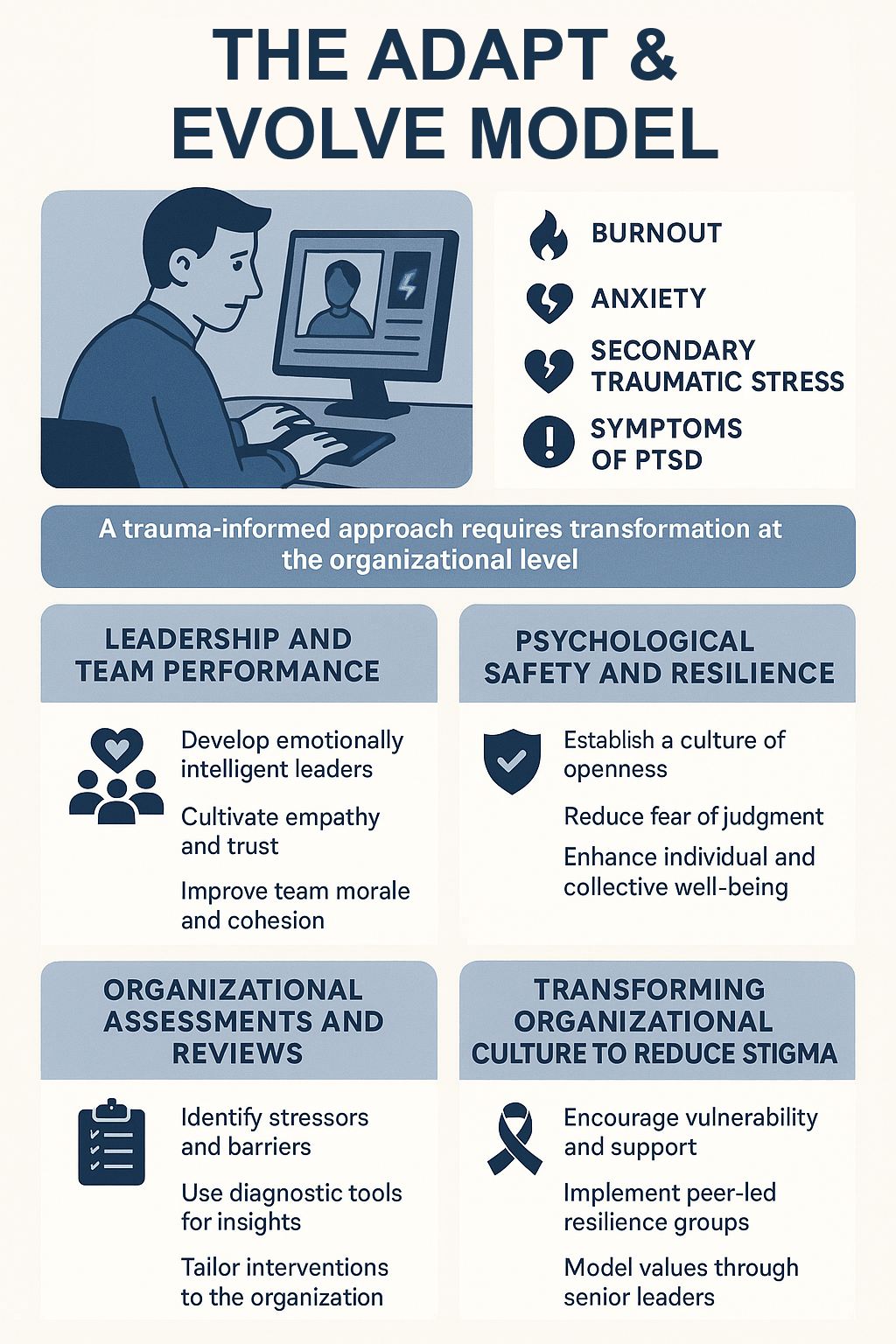
DFIs frequently report that their leaders appear emotionally disengaged, focused solely on operational outcomes while overlooking signs of psychological distress. This disconnection undermines trust and reduces the likelihood that staff will seek help when struggling. Adapt & Evolve’s approach addresses this by equipping leaders with the ability to recognise and respond to stress and trauma within their teams.
Training focuses on empathetic communication, the importance of active listening, and the value of emotional transparency. As leaders begin to model these behaviours, they foster a more trusting and supportive environment, directly influencing team morale, retention, and productivity.
One of the most persistent barriers to mental health support in forensic settings is stigma. To dismantle this, Adapt & Evolve supports organisations in creating psychologically safe environments where vulnerability is not only accepted but encouraged.
Initiatives include establishing peer-led resilience groups and confidential support systems that allow individuals to access help without fear of career consequences. Equally important is the role of senior leaders in modelling these values when those at the top of an organisation share their own experiences and normalise mental health conversations. It signals to staff that seeking support is both valid and encouraged.
Organisations that adopt a trauma-informed approach stand to gain significantly in both human and operational terms. Staff well-being improves as burnout, stress, and emotional exhaustion decline. Teams report increased engagement, stronger cohesion, and greater job satisfaction. Operationally, the benefits are just as significant: psychologically safe teams make fewer errors, collaborate more effectively, and adapt more readily to change. Importantly, trauma-informed practices also foster a sense of shared purpose and organisational integrity, shifting workplace culture towards sustained well-being and excellence.
A truly trauma-informed digital forensic unit begins with a rigorous assessment of organisational health. By identifying leadership shortfalls and cultural barriers, the groundwork is laid for evidence-based intervention. Leadership development should be tailored to the specific needs of DFI teams, prioritising empathy, communication, and trauma-awareness.
Simultaneously, policies must embed psychological safety into daily operations such as confidential reporting channels, flexible workload accommodations, and scheduled well-being check-ins. Creating peer support structures and ensuring these are accessible, trusted, and well-publicised reinforces a culture of shared responsibility and mutual care.
Finally, continuous monitoring and refinement of these practices ensures that organisations remain agile, responsive, and committed to long-term improvement.
The mental health and well-being of Digital Forensic Investigators must be recognised as both an ethical priority and an operational imperative. The Adapt & Evolve integrated framework offers a holistic, evidence-based strategy for fostering resilient teams and supportive leadership. By embedding psychological safety, conducting thorough organisational assessments, and cultivating trauma-informed leadership, forensic organisations can move beyond crisis management and instead build cultures where well-being is actively protected and performance is sustainably enhanced.
Through intentional cultural transformation, DFIs can be supported not just to survive their roles, but to thrive within them—ultimately ensuring that the people at the forefront of digital investigations are given the care, respect, and support they so rightly deserve. For more on this topic, listen to our recent podcast with Adapt & Evolve.
Paul Gullon-Scott BSc MA MSc MSc FMBPSS is a former Digital Forensic Investigator with nearly 30 years of service at Northumbria Police in the UK, specializing in child abuse cases. As a recognized expert on the mental health impacts of digital forensic work, Paul now works as a Higher Assistant Psychologist at Roseberry Park Hospital in Middlesbrough and is the developer of a pioneering well-being framework to support digital forensics investigators facing job-related stress. He recently published the research paper “UK-based Digital Forensic Investigators and the Impact of Exposure to Traumatic Material” and has chosen to collaborate with Forensic Focus in order to raise awareness of the mental health effects associated with digital forensics. Paul can be contacted in confidence via LinkedIn.
Cellebrite’s 2026 Industry Trends Survey is Live
Nearly every modern investigation has a digital element. Right now, professionals in the digital forensics space are dealing with more data and devices than ever before, stretching them to the max and ultimately, slowing case resolution.
Examiners now report an average backlog of three to four weeks and more than a third of the respondents to Cellebrite’s annual Industry Trends Survey say they do not have enough time to fully review the data.
While the digital forensics field is constantly and quickly changing, there is one thing we know for certain: the amount of data and devices will only continue to grow. The question now is what can be done to help professionals in the field keep up?
Every year Cellebrite creates a comprehensive list of questions and poses them to public safety entities in the local, state and federal space, as well as to private sector enterprises. The responses help us get a pulse of the industry, better understand the challenges and gauge any changes happening in the digital investigations field.
Participants from more than 100 countries, ranging from users to supervisors to prosecutors, took part in the public sector’s 2025 Industry Trends Survey. Their unique viewpoints gave us valuable information about a variety of topics, from the importance of digital evidence in the courtroom, to using AI as an assistant and managing the growing amount of data via the Cloud.
Survey responses confirmed for us that digital evidence plays a big role in the courtroom. Juries have now come to expect it as part of what they will review in the case. Our survey revealed that 98% of prosecutors consider digital evidence pivotal to securing convictions. More than half of them told us they believe this evidence type is more important than DNA.

Considering the importance of digital evidence, we want to focus on innovating our solutions for the future. Our goal is to empower users not only with what they need today, but what they will need a few years down the road. Of those who responded to our survey in the public sector, nearly 40% told us they’re open to using cloud technologies for evidence storage and sharing. The reason? The cloud offers both scalability and security advantages.
On the flip side, we also found that 60% of investigators are still using USB sticks for sharing data, even though it is widely recognized as an inefficient avenue, inviting security risks which could compromise the chain of custody.
One respondent left this comment in the survey:
“Cloud-based storage/sharing is the only practical path I see moving forward in DFIR within [law enforcement] LE. The amount of data is just too large, and traditional media is not a viable option to store/transfer [data].”
Responses like this are incredibly valuable as we work on the development of our solutions. The insights not only help us prioritize what’s needed, but they also help us determine the way in which we should shape them to best fit the needs of the industry.
Agency managers are taking note of the changes happening in the field and report a 76% growth in the role of digital data in devices in the past three years. More than half recognize the need for improvement of data management and rated their current strategy as mediocre or poor.
And then there is the topic of AI. 80% of survey respondents said they believe it can make investigations more efficient since it can automate routine tasks. Making the most of their time is a priority for investigators, many of whom reported spending an average of 69 hours per case reviewing multiple devices.
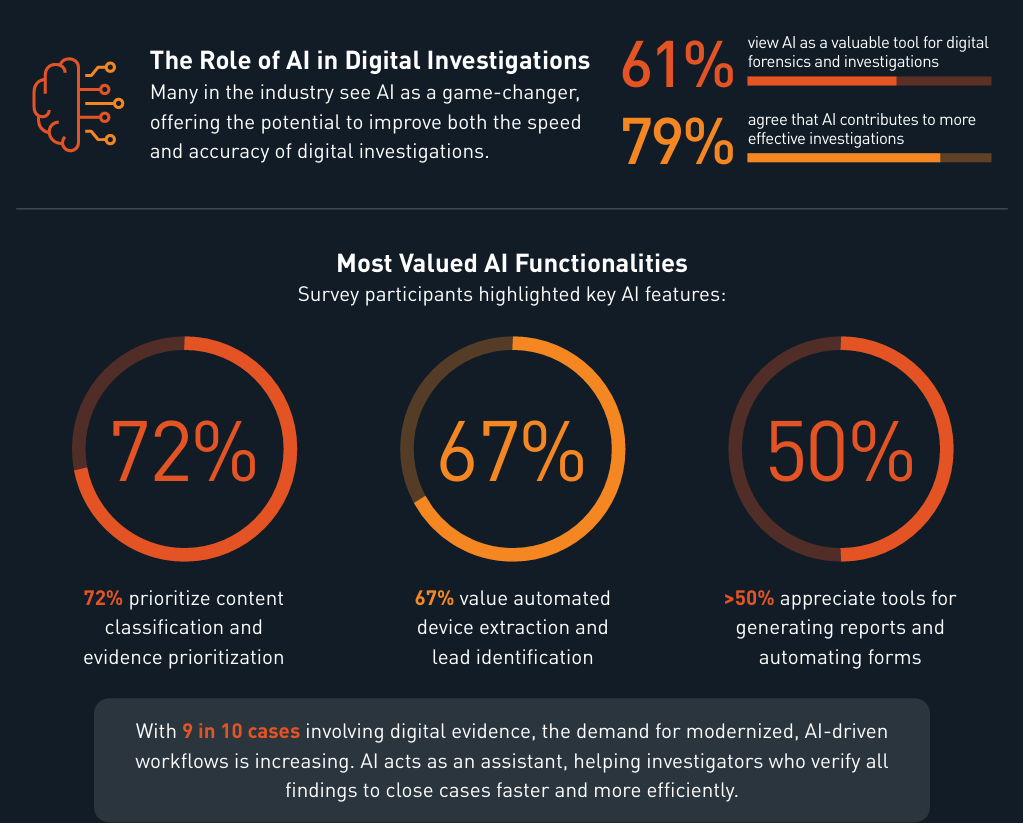
The explosion of digital data isn’t a trend happening only in the public sector. Modern investigations in the private sector now involve much more data than merely emails and documents. Examiners and investigators must also gather data from virtual meeting transcripts, AI-generated summaries and enterprise chat platforms. Since mobile devices are now involved in two-thirds of cases, data from encrypted messaging apps like WhatsApp and WeChat is also involved and gathering that can be tricky.
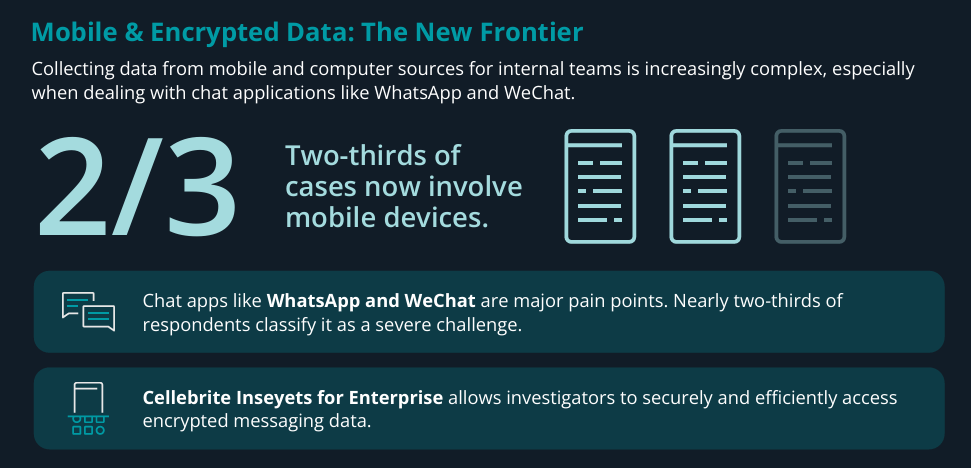
Keeping all of that data in mind, it will come as no surprise that the private sector’s survey showed eDiscovery remaining as the top priority. Investigators need options that give them accuracy, speed and efficiency.
AI-powered solutions are no longer a luxury; they are a necessity. Adoption of AI in the private sector is still in the early stages, yet respondents clearly see its potential. More than two-thirds of respondents said AI can enhance data analysis to help identify patterns and trends more efficiently. More than half said the technology will help reduce manual effort in the collection process. It will never be about replacing human investigators. Rather, it’s about giving them an assistant to work smarter and faster—always with a human verifying the findings.
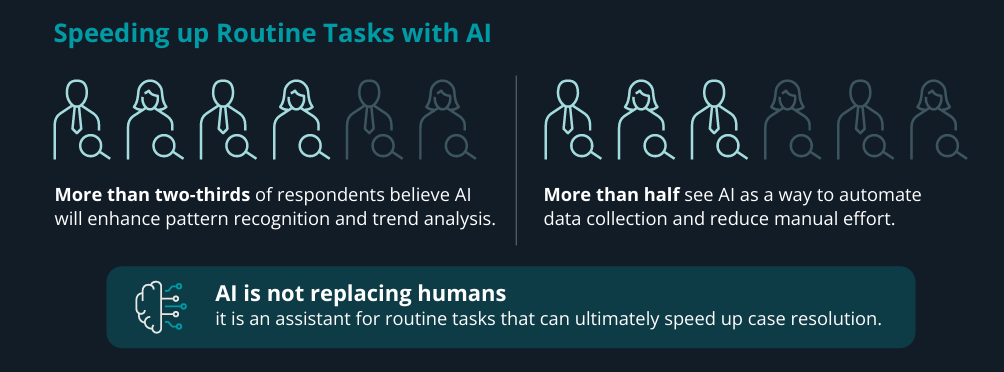
Top priorities for organizations include eDiscovery, with intellectual property theft following closely behind, according to our survey. While there has not been a significant change year over year in the frequency of these cases, the data involved is more complex. Investigators need solutions that can analyze both structured and unstructured data to detect anomalies and prevent breaches before they escalate. All of this information tells us an important story about the industry’s needs, and we look forward to this year’s findings.
The 2026 Industry Trends Survey is live now and will remain open for a little more than a month. In the private sector, this will be the fourth edition of the survey, and it’ll be the seventh edition in the public sector. This is an ongoing, proactive effort from Cellebrite, and we are grateful for those who take a few minutes to weigh in on what is happening in the digital forensics and investigations industry. It helps us help you.
Please join us in helping to shape the future of this industry and take our survey today!
by Paul Gullon-Scott BSc MA MSc MSc FMBPSS
On 12th June 2025, I had the privilege of taking part in a live webinar hosted by Adam Firman, Tech Evangelist at MSAB. We explored the often-overlooked mental health effects experienced by Digital Forensic Investigators (DFIs). The session welcomed approximately 160 participants worldwide, each bringing valuable insights, reflections, and heartfelt questions—clear signs of deep concern within the community about the psychological toll of this work.
One comment stood out for its painful truth: a participant shared that many DFIs, when seeking mental health support, are offered just six therapy sessions. This limit—common across UK services—is presented as a standard intervention, regardless of the depth or duration of trauma a professional may have endured.
In response, I shared something I now feel compelled to expand on more publicly: six therapy sessions are simply not enough. They cannot unpick years of complex psychological trauma, nor can they provide sustainable relief from PTSD, burnout, anxiety, or depression—conditions that are well documented in research.
A skilled therapist might use those initial sessions to create a safe space, build emotional stability, and help a client feel heard. But true healing—real, enduring recovery—requires time, commitment, and compassion. For me, it took 14 months of weekly intensive counselling before I began to feel like my old self again.
Digital Forensic Investigators are the unsung heroes of digital crime investigations, routinely engaging with disturbing material. From indecent imagery of children to evidence of extreme violence, DFIs are exposed to content the average person would never have to witness—let alone analyse in detail for hours on end. This constant exposure changes your worldview. It does not leave you unscathed.
Research shows repeated exposure to traumatic digital material has cumulative effects on mental health. Prolonged contact with child sexual abuse material (CSAM), for example, is linked to higher levels of secondary traumatic stress, intrusive thoughts, emotional numbing, PTSD, and Complex PTSD. Previous studies confirm that DFIs report high rates of burnout, emotional exhaustion, and depressive symptoms—conditions that impair both professional performance and personal wellbeing.
Offering six sessions may stem from good intentions—to make support accessible—but for those immersed in psychologically damaging content for years, this limit risks further harm. Short-term therapy can give the illusion of support while failing to meet actual needs.
Therapists often use the first few sessions to build rapport and assess the trauma’s scope. Many DFIs are emotionally guarded from years of compartmentalisation. For them, it can take weeks or months to open up. In this context, a six-session limit serves as triage, not treatment. At best, it starts the healing process. At worst, it reinforces the belief that their suffering isn’t worth more time.
Each person’s path to recovery is unique. Trauma doesn’t follow arbitrary timelines. One person might respond well to short-term CBT. Another may require over a year of EMDR, psychodynamic, or trauma-informed therapy to feel functional again.
In my case, therapy didn’t erase what I’d seen—those memories remain—but it taught me how to live alongside them. Therapy helped me reframe my experience, turning pain into insight, and helping me move forward with purpose.
When I began therapy, I was shattered, angry, and burned out. Over more than a year, with the help of a consistent, non-judgmental therapist, I began to rebuild myself. That journey was not linear. Some weeks brought breakthroughs. Others brought stalemates. At times, I wanted to give up. But that long-term support allowed me to rediscover who I was.
Looking back, I realise how much I had changed. I thought I was hiding my struggles well. But all I see now is the fear in the eyes of those who love me, watching me become withdrawn, irritable, emotionally numb—unreachable.
If my therapy had been cut off at six weeks, I might have internalised the message that my pain didn’t matter. I truly don’t want to imagine what might have happened. We cannot allow this to be the message DFIs receive.
During the MSAB webinar, participants were asked: “Are you satisfied with the current level of mental health support?” Sixty-nine percent answered NO.
This speaks volumes. It shows that mental health provision is not keeping pace with the needs of the workforce. When support is offered, it’s often generic and inflexible. DFIs, who work tirelessly to protect others, are not being adequately protected themselves.
You wouldn’t send a soldier into battle without body armour—so why are DFIs being sent into digital battlegrounds without proper psychological protection?
In the UK, mental health provision is largely reactive—often only initiated when professionals begin to show signs of distress. But during the webinar, another question was asked: “Would a more proactive approach to mental health and wellbeing be helpful—for example, psychoeducation around the mental health issues you may face?”
An overwhelming 97% of participants said yes.
Given the rising volume and complexity of CSAM cases, why hasn’t mental health provision evolved? Equipping investigators to recognise and respond to psychological stressors—through self-care, peer support, or early access to therapy—could help reduce or even prevent long-term harm.
Investigators are routinely trained to use new forensic tools—but where are the courses on how to care for themselves?
Mental health must not be an afterthought or a crisis response. It must be a core component of training and professional development in digital forensics. We prepare investigators to face technical challenges; surely, we must also prepare them to manage emotional ones.
Mental health support needs to be:
A rigid cap of six sessions contradicts everything we know about trauma recovery.
Therapy is not a luxury for DFIs—it is a necessity. It enables professionals to process what they’ve witnessed, regulate their responses, and return to a place of psychological balance. The importance of long-term access cannot be overstated. It:
It’s time to remove arbitrary therapy limits for those in trauma-heavy roles. The psychological injuries DFIs endure are occupational hazards—just like physical injuries in frontline sectors.
A broken leg wouldn’t be expected to heal in six weeks without proper care. Why should complex trauma?
Organisations must review and improve their mental health policies. This could include:
If you are struggling, please know this: your distress is not weakness. It’s a natural human response to inhuman material.
Seeking help is not a sign of failure—it is an act of courage. Speaking from my own experience, I understand how daunting it can feel. The idea of revisiting the cases that haunt your sleep, of putting words to the images that linger in your mind, can be terrifying.
Therapy isn’t about reliving trauma—it’s about learning how to live with it in a way that no longer changes who you are. It’s a space where you can begin to process, understand, and gradually let go of the weight you’ve been carrying.
With time, support, and self-compassion, you will come through this stronger, more grounded, and more connected to yourself and those who care about you.
You are doing incredibly important work—but your wellbeing matters just as much.
Please take that first step.
You deserve more than six sessions. You deserve care that meets you where you are, and stays with you for as long as you need.
If you take one thing from this article, please remember:
Every person heals at their own pace. Your pain is valid. Your recovery matters. You are not alone.
Paul Gullon-Scott BSc MA MSc MSc FMBPSS is a former Digital Forensic Investigator with nearly 30 years of service at Northumbria Police in the UK, specializing in child abuse cases. As a recognized expert on the mental health impacts of digital forensic work, Paul now works as a Higher Assistant Psychologist at Roseberry Park Hospital in Middlesbrough and is the developer of a pioneering well-being framework to support digital forensics investigators facing job-related stress. He recently published the research paper “UK-based Digital Forensic Investigators and the Impact of Exposure to Traumatic Material” and has chosen to collaborate with Forensic Focus in order to raise awareness of the mental health effects associated with digital forensics. Paul can be contacted in confidence via LinkedIn.
Forensic video analysts face a new level of complexity with the increasing use of H265/HEVC in modern surveillance systems. If you’re working with H265/HEVC video, you may already know how challenging its compression can be.
To help you address this challenge, Amped Software has introduced the Coding Tree Units (CTU) filter in Amped FIVE. A tool designed to decode and visualize the structure of H265 video at the block level. Essential for understanding image reliability and integrity.
In this article, you’ll learn why Coding Tree Units matter, what they reveal about your footage, and how to use this filter in your forensic investigations.
Coding Tree Units are the foundational building blocks of video encoded with H265/HEVC. Unlike older standards like H264, which used smaller “macroblocks” (typically 8×8 or 16×16 pixels), CTUs can be as large as 64×64 pixels. These blocks are subdivided into smaller Coding Units (CUs) and Prediction Units (PUs) based on image complexity and motion.
Why does this matter? Because how a frame is divided and compressed affects how reliable and detailed the image truly is. Understanding CTUs lets you see whether a part of the image was truly captured or merely copied from a previous frame.
The structure enables highly adaptive compression but introduces variability in how image regions are encoded. From a forensic perspective, this variability can obscure critical image features or create encoding artifacts that impact interpretation.
If you’re analyzing video evidence during an investigation and to be presented in a courtroom, it’s not enough to “see” an object in a frame. You need to verify its authenticity and reliability. Here’s why understanding CTUs is important:
By analyzing CTUs, you get a behind-the-scenes look at how the image was formed. This allows you to make informed judgments about its forensic value.
1) Access the filter
Navigate to the Verify filter category. Locate “Coding Tree Units” or use the quick search bar. The filter interface includes two tabs: Settings and Legend.
2) Consult the Legend first
Before activating overlays, review the Legend tab. Color codes indicate:
This legend parallels Amped FIVE’s Macroblocks filter but is adapted for HEVC.
3) Enable CTU Subdivision Visualization
In the Settings tab, check the option for CTU Subdivisions. This overlay maps how each 64×64 unit is broken into smaller coding units. Irregular subdivisions typically indicate regions of interest or image complexity.
4) Analyze Prediction Units
Enable Prediction Units to see how the encoder handled motion:
Use this to understand why a specific area lacks detail or appears distorted.
5) Inspect Motion Vectors
For video with B or P frames, activate Motion Vectors. Arrows will illustrate the spatial relationship between the encoded block and its reference source. This is particularly valuable when tracking objects or validating object persistence across frames.
6) Evaluate Spatial Compression via Quantization
Overlay the Quantization Parameter to determine the level of spatial compression applied per unit. A QP closer to 51 suggests aggressive compression, often resulting in loss of detail critical to forensic tasks.
One of the main takeaways from using this filter is that more pixels don’t always mean more usable information. For example, a 4K video might appear sharp overall but lose crucial detail in motion or low-light areas due to compression.
A license plate might be visible in one frame, then completely unreadable in another. That’s simply because the encoder skipped or heavily compressed that region. CTU analysis can explain why this happens, helping you decide whether restoration is even possible.
Amped Software developed the tool because you need more than just visual clarity, you need data integrity. The CTU filter allows you to:
The CTU filter empowers you to assess whether an image is trustworthy, explains why detail may be missing, and supports your analysis with visual proof.
In forensic video analysis, knowing how data was captured is as important as the data itself. Use the CTU filter in Amped FIVE to reveal the invisible structure behind every frame.
This article only scratches the surface, to get deeper into the theory behind CTU analysis, read the full blog post.
by Paul Gullon-Scott BSc MA MSc MSc FMBPSS
Digital forensics often involves content related to child sexual abuse, terrorism, extreme violence, or murder, leaving investigators vulnerable to vicarious trauma, compassion fatigue, and burnout. Despite growing awareness of the mental health risks associated with such work, organisational attitudes frequently perpetuate unhelpful narratives. Phrases such as “you need to be made of the right stuff” or “you knew what you were signing up for” are commonly reported by digital forensic professionals and reflect deeper organisational cultures that may inadvertently contribute to psychological harm.
Comments like this, which minimise and individualise stress responses, are not merely insensitive—they can be psychologically damaging. They reflect and reinforce an organisational culture that externalises responsibility for mental health, stigmatises vulnerability, and obstructs access to support, with serious implications not only for individuals but also for the organisations themselves. This article explores the psychological impact of these narratives, grounding the discussion in theories of trauma, resilience, organisational justice, and occupational stress.
Vicarious trauma (VT) refers to the transformation that occurs in professionals as a result of empathetic engagement with trauma survivors or traumatic material. McCann and Pearlman describe VT as a process that can result in significant cognitive, emotional, and interpersonal changes. In digital forensics, where exposure to graphic and distressing content is routine, the risk of VT is pronounced.
The phrase “you need to be made of the right stuff” implies a binary distinction between those who are innately suited to cope and those who are not. It reflects a flawed perception of resilience as a static trait rather than a dynamic process. Bonanno and Lee et al emphasise that resilience is influenced by multiple factors, including family and/or peer support, coping strategies, and organisational context—all of which have been identified in previous research in this area as protective factors—as opposed to inherent toughness or stoicism.
In effect, this narrative not only places blame on the individual for experiencing stress but also discourages them from seeking help, for fear of being perceived as lacking the “right stuff” or as somehow weak. This can lead to suppression of symptoms, reduced engagement with occupational / mental health services, and delayed interventions, which ultimately increases the risk of long-term psychological injury.
The phrase “you knew what you were signing up for” is particularly invalidating. It dismisses the cumulative impact of trauma exposure by suggesting that suffering is the expected consequence of the role. This can generate moral injury, defined as the psychological distress resulting from actions (or inactions) that violate one’s moral or ethical beliefs.
In this context, the injury arises not from the traumatic material itself, but from the organisational response to distress and their inaction in properly addressing the issue at hand. Workers may feel abandoned, betrayed, or devalued, particularly if they perceive a lack of compassion, support or fairness in how their concerns are handled. Over time, this can lead to feelings of shame, failure, hopelessness, and detachment from the organisation, all of which are strongly associated with depression, PTSD, and burnout.
Furthermore, such comments undermine the legitimacy of mental health support and encourage a culture of silence. This culture is particularly harmful in investigative environments, where openness about psychological wellbeing is already constrained by stigma and concerns about professional credibility.
The psychological contract refers to the unspoken expectations between employees and employers. When individuals enter a profession like digital forensics, they may accept the challenging nature of the role—though nothing can truly prepare them for what they will face—but they also expect proper mental health support, respect, and acknowledgement from their organisation.
When this contract is violated through dismissive comments or inadequate wellbeing provisions, the result is psychological contract breach, which is associated with reduced job satisfaction, organisational commitment, and increased turnover intentions.
Perceived organisational support (POS) theory further explains how employees form general beliefs about how much their organisation values their contributions and cares about their wellbeing. When phrases like “you knew what you were signing up for” are used, POS is undermined. Employees are left feeling that their wellbeing is secondary to operational demands, which can exacerbate stress and lower morale.
Digital forensic investigators often derive a strong sense of identity from their work. The role is typically viewed as vital, specialist, and impactful. However, when struggling with the psychological toll, these same individuals may experience shame and self-stigmatisation, especially if the dominant narrative suggests that only the weak are affected.
According to Gilbert’s model of shame, individuals internalise negative evaluations, leading to a diminished self-view. In organisational cultures that promote stoicism, this shame can prevent workers from acknowledging distress, resulting in isolation, reduced help-seeking, and potentially maladaptive coping behaviours, such as alcohol or drug use, emotional numbing, or absenteeism.
Changing the narrative begins with shifting from an individualised model of stress to a systemic, trauma-informed organisational approach. This involves recognising that these professionals are only human—they are not made of steel—and that wellbeing is shaped not only by exposure but by how exposure is managed.
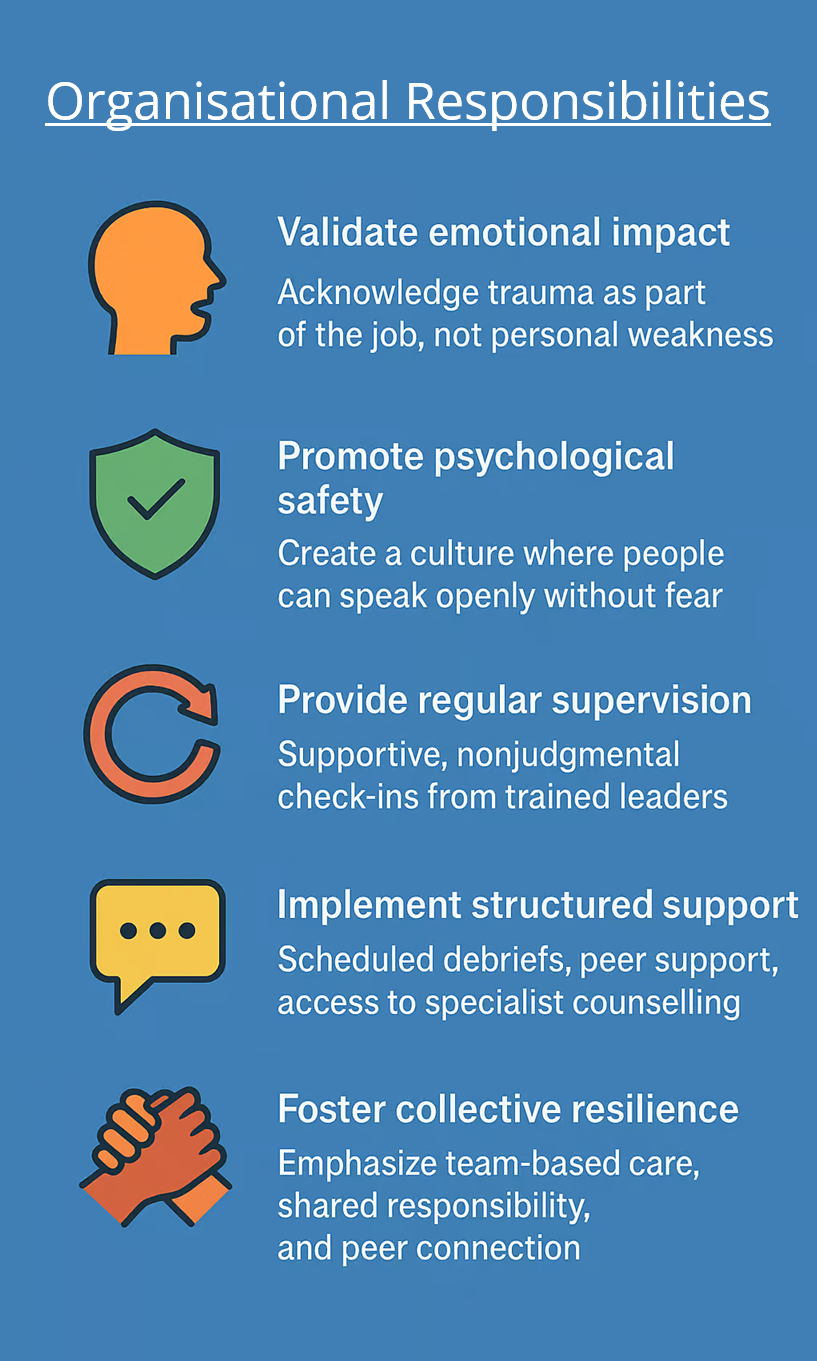
A trauma-informed workplace is one that:
This approach contrasts sharply with the minimising language discussed earlier. By adopting a compassionate model, organisations affirm that wellbeing is not a sign of weakness, but an ethical, moral and operational priority.
To move beyond damaging narratives and foster a psychologically safe environment in digital forensic units, the following recommendations are proposed:
The work of digital forensic investigators is not only technically complex but emotionally taxing. The use of phrases like “you need to be made of the right stuff” or “you knew what you were signing up for” reflects an outdated and harmful organisational narrative that denies the psychological impact of the role.
By understanding the impact of these narratives through the lens of psychological theory, organisations can begin to take responsibility for the mental wellbeing of their staff. Moving towards trauma-informed, compassionate, and supportive organisational cultures is not just a moral requirement; it is essential for the sustainability, safety, and effectiveness of the digital forensic workforce.
These kinds of comments often come from a place of misunderstanding rather than malice. They can dismiss the very real emotional impact which inherently comes with this work. I speak from experience when I say that digital forensic investigators face things most people could never imagine and carry that weight quietly and professionally. Any suggestion that distress is a sign of weakness, or something they “signed up for,” ignores the human cost involved.
We must stop using outdated narratives and instead show compassion, listen without judgment, and create space for people to talk openly about how they’re feeling. That’s how we protect not only their mental health but also the integrity and sustainability of the profession itself.
Paul Gullon-Scott BSc MA MSc MSc FMBPSS is a former Digital Forensic Investigator with nearly 30 years of service at Northumbria Police in the UK, specializing in child abuse cases. As a recognized expert on the mental health impacts of digital forensic work, Paul now works as a Higher Assistant Psychologist at Roseberry Park Hospital in Middlesbrough and is the developer of a pioneering well-being framework to support digital forensics investigators facing job-related stress. He recently published the research paper “UK-based Digital Forensic Investigators and the Impact of Exposure to Traumatic Material” and has chosen to collaborate with Forensic Focus in order to raise awareness of the mental health effects associated with digital forensics. Paul can be contacted in confidence via LinkedIn.
by Paul Gullon-Scott BSc MA MSc MSc FMBPSS
In April 2025, Europol announced the dismantling of one of the largest online child sexual abuse material (CSAM) networks ever discovered. The operation spanned 19 countries and led to the arrest of 25 individuals. Investigators identified hundreds of thousands of images and videos, including AI-generated material designed to evade detection while maintaining disturbing realism.
While the public rightly applauded the results of this extraordinary international collaboration, few paused to consider the human cost behind such operations. Specifically, the toll borne by the digital forensic professionals who sift through unimaginable material in the pursuit of justice and to safeguard those children who have been abused.
For those on the frontline of digital child protection, the task is not only technically complex but also psychologically demanding.
Digital forensic investigators working on CSAM cases are routinely exposed to content depicting the sexual abuse and exploitation of children. Unlike other areas of forensic work, this exposure is not secondary or occasional – it is central to the role and often occurs every day. It requires repeated and prolonged engagement with traumatic material, often under intense pressure to secure timely convictions or prevent further harm to victims.
The emotional and psychological risks associated with this work are well-documented. Research has found that professionals in this field report high levels of stress, anxiety, depression, and symptoms consistent with post-traumatic stress disorder (PTSD). According to a 2023 study published in BMC Psychiatry entitled “The Mental Health of Officials Who Regularly Examine Child Abuse Material: Strategies for Harm Mitigation”, exposure to violent CSAM was significantly associated with elevated PTSD symptoms among digital forensic analysts. The intensity of the imagery, coupled with the repetitive and isolating nature of the work, can produce cumulative trauma over time.
This exposure doesn’t only affect professional performance; it can spill over into personal lives. Investigators often report a deterioration in their relationships, increased irritability, sleep disturbances, and a sense of emotional detachment. Many develop unhealthy coping mechanisms, such as emotional numbing, hypervigilance, or avoidance. This condition, sometimes referred to as “vicarious trauma” or “secondary traumatic stress,” reflects the deep emotional impact of working with the suffering of others, even indirectly.
Despite these realities, mental health challenges within digital forensics remain largely hidden. A culture of stoicism, fear of stigma, and concerns about career repercussions often prevent professionals from seeking help. Some worry that admitting to emotional distress may be seen as weakness or a liability, particularly in roles requiring high levels of security clearance or psychological resilience.
Organisations and agencies may unwittingly reinforce this culture by failing to acknowledge the psychological risks inherent in the role. In some instances, support structures are inadequate, poorly promoted, or simply not trusted by staff. Many investigators report feeling unsupported, isolated, and undervalued, particularly when their work is misunderstood by colleagues or the wider criminal justice system.
In this environment, burnout becomes a serious risk. Professionals can become emotionally exhausted, cynical, and disengaged—not only from their work, but from the values that initially drew them to it.
The impact of CSAM work on digital forensic investigators is not inevitable. With the right organisational culture and support structures, the psychological burden of the role can be managed more effectively. Agencies have a duty of care to protect not just the physical safety of their employees, but their mental well-being too.
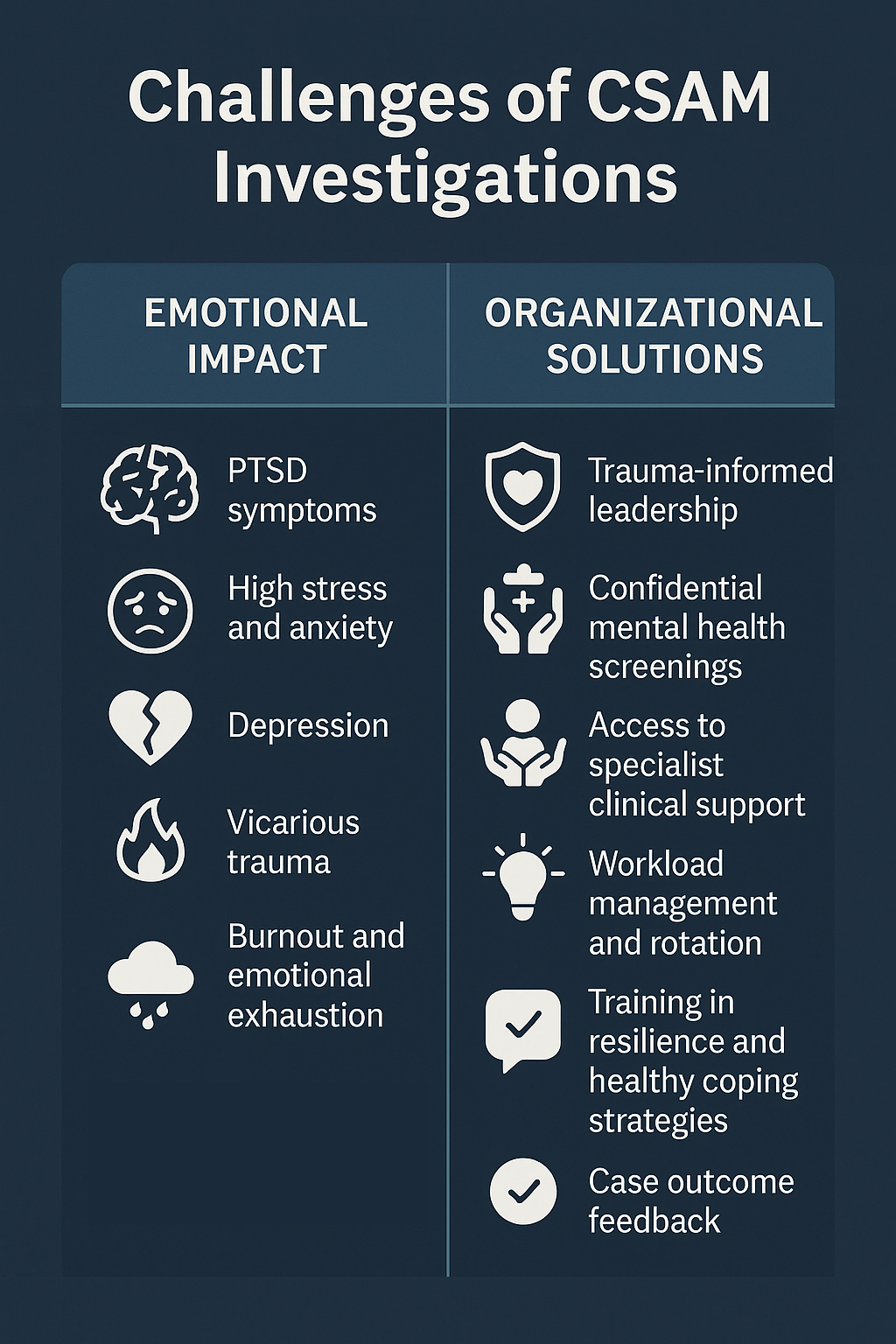
The rise of artificial intelligence is creating new challenges for digital forensic investigators. AI-generated CSAM, sometimes referred to as “synthetic abuse material,” is becoming more sophisticated, realistic, and difficult to detect. Although such images may not depict real victims in a traditional sense, their production and distribution still contribute to harmful cultural narratives and may be used alongside real abuse to normalise deviant behaviours.
For investigators, AI-generated material can be just as psychologically distressing. The uncanny realism can trigger the same emotional responses as genuine material, while adding layers of ethical ambiguity and investigative complexity. Sorting real from synthetic adds to the cognitive load, time pressure, and psychological strain already present in the work.
This technological evolution underscores the urgency of equipping digital forensic professionals with appropriate mental health support not only to sustain their well-being but to ensure the effectiveness of investigations in an increasingly complex landscape.
While the psychological impact of CSAM investigations has been acknowledged in academic literature and some policy discussions, much more needs to be done to bring about meaningful change. We must move beyond awareness and into action.
This begins with breaking the silence. It is vital to normalise discussions around mental health in digital forensics and create environments where professionals feel safe to express distress without fear of judgement or consequence. Training for managers and peers in how to respond empathetically to disclosures of psychological difficulty is a critical part of this process.
We must also recognise the emotional labour inherent in this field as a form of expertise. Digital forensic investigators are not only skilled professionals; they are psychological first responders, absorbing and interpreting traumatic material on behalf of the justice system and society at large. Their well-being should be treated with the same seriousness as their technical and professional competence.
The work of digital forensic professionals in tackling online child exploitation is essential and heroic. They operate at the sharpest edge of criminal justice, often hidden from public view, with little recognition. But this work comes at a cost – a cost that cannot be borne silently or alone.
As CSAM investigations become more complex and voluminous, particularly with the emergence of AI-generated content, the need to support the mental health of digital forensic investigators becomes ever more pressing. This is not simply an operational concern; it is a moral imperative.
To protect the protectors, we must invest in systems, cultures, and conversations that value mental health as much as technical expertise. Only then can we ensure that those tasked with confronting the darkest corners of the internet do not become lost in the darkness themselves.
If you’re a professional working in or alongside digital forensics and have insights, experiences, or resources to share, now is the time to speak up. Together, we can build a culture of resilience, understanding, and respect for those who do this vital work.
Paul Gullon-Scott BSc MA MSc MSc FMBPSS is a former Digital Forensic Investigator with nearly 30 years of service at Northumbria Police in the UK, specializing in child abuse cases. As a recognized expert on the mental health impacts of digital forensic work, Paul now works as a Higher Assistant Psychologist at Roseberry Park Hospital in Middlesbrough and is the developer of a pioneering well-being framework to support digital forensics investigators facing job-related stress. He recently published the research paper “UK-based Digital Forensic Investigators and the Impact of Exposure to Traumatic Material” and has chosen to collaborate with Forensic Focus in order to raise awareness of the mental health effects associated with digital forensics. Paul can be contacted in confidence via LinkedIn.
In the fight against child sexual abuse material (CSAM), the need for accurate, timely, and secure intelligence is more crucial than ever. Semantics 21 (S21) understands this urgency and offers a game-changing solution through the S21 Global Alliance Database (S21 GAD)—the largest global CSAM intelligence database available. With over 3 billion records and growing rapidly, contributed exclusively by law enforcement agencies worldwide, the S21 GAD is an indispensable tool for investigators aiming to identify and protect victims while simultaneously bringing perpetrators to justice.
At the core of the S21 GAD’s power is its ability to streamline investigations, reduce time spent reviewing irrelevant materials, and provide investigators with immediate access to a wealth of international data. S21’s commitment to technology-driven solutions ensures that every victim matters—a driving principle that powers our mission to create a safer world through collaboration and innovation.
For nearly a decade, Semantics 21 has stood shoulder to shoulder with law enforcement agencies worldwide – earning not only their trust but also national recognition, including the prestigious Queen’s Award for Enterprise: Innovation in 2019 and the King’s Award for Enterprise: Innovation in 2024. These honours reflect our unwavering commitment to supporting those on the front lines of the fight against child sexual abuse material (CSAM).
At the heart of everything we do is a simple but powerful belief: Every Victim Matters. We don’t just build technology – we build tools that empower investigators to act faster, smarter, and with greater impact.

Our flagship tool, S21 LASERi-X, is already helping to identify thousands of victims each year, enabling rapid categorisation of CSAM, surfacing critical intelligence, and supporting the pursuit of justice. But today, we go further.
Introducing the S21 Global Alliance Database (GAD) – the world’s largest CSAM intelligence database with over 3 billion law enforcement contributed records, and growing rapidly.
Although only two years old, the S21 GAD has already made a significant impact across the globe. Trusted by agencies in the UK, USA, Canada, and many others, it is accelerating case processing, aiding victim identification, and safeguarding investigator mental wellbeing by drastically reducing the volume of material that must be manually reviewed.
The database is growing rapidly, fuelled by contributions from law enforcement worldwide. This collaborative intelligence-sharing model enables investigators to benefit from each other’s categorisation work, surface potential victims faster, and operate with unmatched efficiency – all while supporting each other’s resilience.

The growth and early adoption of the S21 GAD speak volumes: investigators need a solution that is free, easy, scalable, and accurate – and that’s exactly what we’ve delivered. Previous attempts were embroiled in inaccuracies, siloed environments, commercialisation, and came with eye watering costs – this is proudly different.
S21 LASERi-X delivers powerful results within an organisation. The S21 Global Alliance Database delivers global transformation.
Now is the time to get involved. With bold plans for expansion and new capabilities on the horizon, the S21 GAD offers an unprecedented opportunity to enhance investigations and protect more victims than ever before.
Access is free for law enforcement. Join the alliance. Make the difference.

The S21 GAD provides investigators with a powerful tool to accelerate investigations and improve the efficiency of digital forensics work. Key features and benefits include:
• Free Access for Law Enforcement:
– The S21 GAD is completely free to law enforcement and associated agencies, offering unrestricted access to critical global intelligence at no cost.
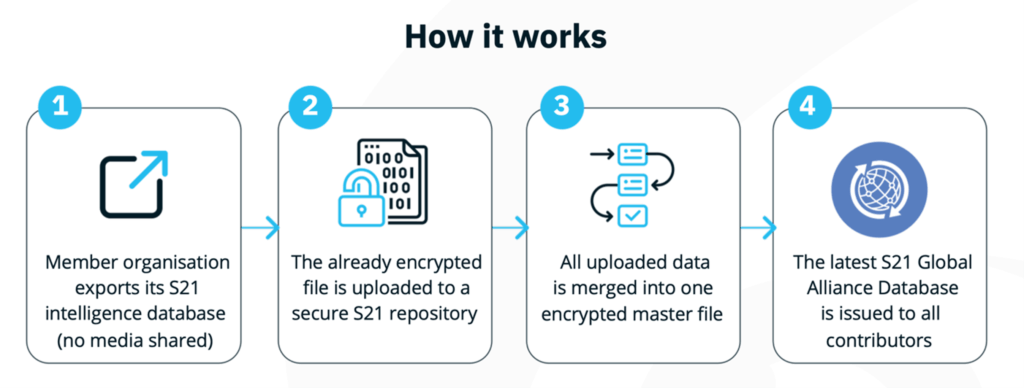
• Global Intelligence Network:
– With over 3 billion records and growing rapidly, the S21 GAD includes CSAM, revenge pornography, counter-terrorism material, and more, allowing investigators to identify known content and victims faster.
• Efficient Case Processing:
– Pre-categorisation of Files: Instantly match files against the S21 GAD, reducing review times by automatically identifying known content.
– Pre-categorises 70%+ of Media: Efficiently sort through media, saving time and improving case turnaround.
• Real-time Victim Identification:
– Global Victim Identification: Quickly locate potential victims, including those in unknown CSAM files, through an expansive database with millions of relevant records.
– Cross-border Collaboration: Facilitate the seamless exchange of intelligence between international law enforcement agencies.
• Enhanced Security & Privacy:
– The S21 GAD contains only hash and metadata, with no images or videos stored, prioritising privacy and security.
– End-to-End Encryption and GDPR Compliance: Fully secure with end-to-end encryption and GDPR-compliant processes, ensuring safe handling of sensitive data.
• Data Integrity:
– Dynamic Voting System: A self-cleansing system that helps avoid inaccuracies, maintaining the integrity and reliability of the database.
– Secure, Contribution-led Database: Only law enforcement-contributed data, ensuring accuracy and relevancy.
The S21 GAD offers a unique advantage: it connects investigators to a vast network of information that is central to the fight against CSAM and other forms of online exploitation. Here’s how the S21 GAD helps:
• Faster Investigations:
– With the ability to match evidence against a global intelligence network instantly, investigators can reduce time spent reviewing irrelevant material, allowing them to focus on critical files that can lead to the identification of victims and perpetrators.
• Increased Victim Identification:
– Through its database, investigators can identify potential victims even when the abuse is not directly linked to other known cases, broadening the scope of their search and increasing the likelihood of finding survivors.
• Secure, Contribution-led Database:
– The S21 GAD only includes records contributed by law enforcement agencies, ensuring no images or videos are stored. It contains hash and metadata only, prioritising privacy and security.

• Social Media Integration:
– Our next phase is to work with social media companies to allow them to probe a simplified version of the S21 GAD. This version will help them determine if a file being uploaded is notable, enabling immediate intervention to prevent the upload and take down illicit material. Only by working together as Police, vendors and social media can we hope to stop this CSAM epidemic.
• Collaboration with Digital Forensic Providers:
– Following that, we plan to welcome third-party digital forensic providers to integrate with the S21 GAD. Many of these providers have already signed up, and their participation will further expand the database’s reach and utility. Please encourage your tool of choice to reach out for connection to the S21 GAD for your investigations.

If you’re not using the S21 Global Alliance Database (S21 GAD), you’re missing out on a revolutionary tool that’s significantly speeding up investigations, helping to rescue more victims, and ensuring the mental wellbeing of your team. The S21 GAD provides you with the intelligence you need to process cases faster and make a bigger impact on the fight against CSAM.
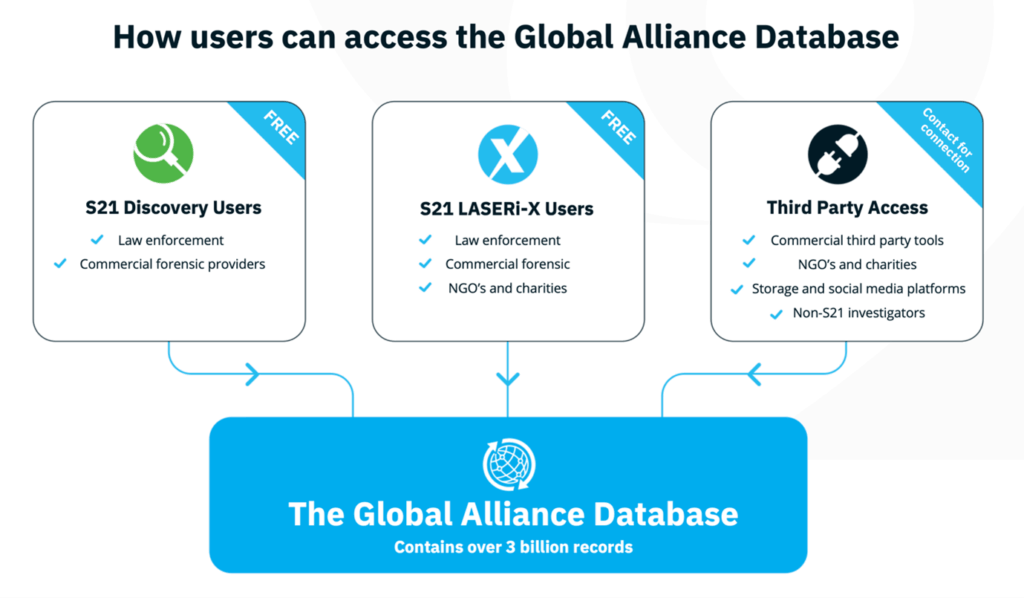
Now is the time to get connected, learn more, and explore how the S21 GAD can transform your investigations. Watch our webinar to see how it works, or visit our website to learn more about how to leverage the power of the S21 GAD in your organisation.
At Semantics 21, we are committed to supporting you in your mission to protect vulnerable individuals, solve crimes, and bring justice to those who exploit the innocent. Get connected today and become part of the change.
by Paul Gullon-Scott BSc MA MSc MSc FMBPSS
Digital forensic investigators (DFIs) play a vital role in the criminal justice system, often examining distressing material such as child exploitation images, violent crime evidence, and cyber offenses. The emotional toll of this work is significant, leading to challenges such as vicarious trauma, burnout, and secondary traumatic stress disorder (STSD).
Despite the known risks, mental health management in this field has traditionally been reactive, addressing symptoms after they appear. Reactive strategies, while necessary, often fail to address the root causes of stress, leaving DFIs vulnerable to chronic emotional challenges. By contrast, preventative approaches focus on equipping investigators with tools and strategies to maintain resilience and mental health proactively.
This article explores the benefits and limitations of both reactive and preventative approaches, drawing on recent research and practitioner insights. By evaluating the strengths and shortcomings of each, we advocate for a more balanced, hybrid strategy that better supports the long-term wellbeing of those working in digital forensics.
The work of DFIs is uniquely demanding due to prolonged exposure to graphic material and the psychological impact of investigating serious crimes. Investigators working on child exploitation cases often report elevated stress levels, with symptoms indicative of secondary traumatic stress. This exposure, coupled with the pressure to meet investigative deadlines, exacerbates emotional strain and leads to a cumulative emotional toll. Many investigators also experience a conflict between their professional responsibilities and the personal toll of witnessing humanity’s darkest behaviors.
In addition to the emotional challenges, organizational factors can amplify stress. Systemic issues exist, such as insufficient institutional support, inadequate training, and high workloads. Investigators frequently report feeling isolated, with limited opportunities for structured emotional processing. Many organizations lack mechanisms such as formal debriefing sessions, leaving investigators to manage their stress in isolation. This lack of support underscores the need for proactive measures to address both the emotional and organizational dimensions of mental health management.
Preventative strategies aim to equip DFIs with the tools needed to handle emotional challenges before they escalate. Resilience training is a cornerstone of this approach, focusing on helping investigators develop coping mechanisms and emotional regulation skills. Research suggests that resilience training can reduce burnout and vicarious trauma among investigators, highlighting its effectiveness as a proactive intervention. These programs often incorporate mindfulness practices, cognitive behavioral techniques, and stress management exercises.
Structured debriefing sessions are another vital preventative measure. Regular, formal debriefings, which provide investigators with a safe space to reflect on their experiences and receive support from peers and supervisors, are important. Organizations that prioritize these sessions often report lower levels of burnout and higher job satisfaction among their staff.
Flexibility in work policies also plays a significant role in prevention. Allowing investigators to adjust their schedules or take mental health leave can help them balance professional demands with personal needs. Creating a workplace culture that normalizes mental health discussions further reduces the stigma of seeking help, enabling investigators to access support without fear of judgment.
However, the success of preventative strategies depends on sustained organizational commitment. Without sufficient resources or consistent leadership support, even well-designed programs may fail to achieve their intended impact.
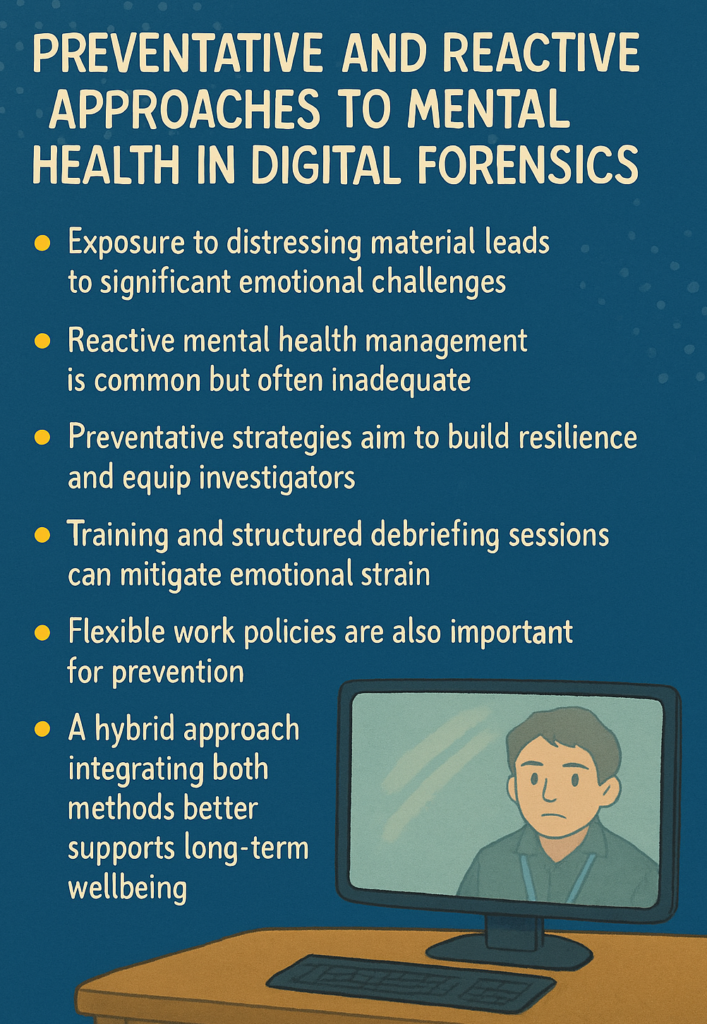
Reactive strategies focus on addressing mental health challenges once they have already emerged. These approaches include crisis counseling, therapy, and post-incident debriefings. Reactive measures are particularly effective in managing acute mental health crises, such as severe distress following exposure to graphic content. Employee Assistance Programs (EAPs), for instance, provide short-term counseling services that can help investigators process their emotions and develop coping strategies.
However, reactive approaches have notable limitations. Delays in addressing mental health risks or reliance on negative coping mechanisms can exacerbate secondary traumatic stress (STS) levels, and providing education and support systems is vital to mitigate these risks. Reactive measures also tend to focus on individual recovery, often neglecting the systemic factors such as high workloads and poor organizational support that contribute to mental health challenges. As a result, they are often less effective in preventing future episodes of distress.
Despite these limitations, reactive strategies remain essential for addressing immediate needs. When combined with preventative measures, they create a more comprehensive approach to mental health management.
Preventative and reactive approaches each offer unique benefits and limitations. Preventative strategies build resilience, reduce the stigma surrounding mental health, and promote long-term wellbeing and prevent staff turnover. However, they require investment and depend on organizational commitment. Reactive strategies, by contrast, are crucial for addressing acute crises but are less effective in mitigating chronic stressors or preventing future issues such as the loss of experienced investigators.
A hybrid approach that integrates both methods provides the most effective solution. For instance, organizations could implement resilience training and regular debriefings while also ensuring access to crisis counseling and EAPs. This combination ensures that both immediate and long-term needs are addressed, fostering a supportive and sustainable work environment.
To effectively address the mental health challenges faced by DFIs, organizations should adopt a comprehensive strategy that incorporates both preventative and reactive measures. Key recommendations include:
Digital forensic investigators face significant mental health challenges due to the emotionally demanding nature of their work. While reactive approaches are essential for addressing immediate crises, they must be complemented by preventative strategies that promote long-term resilience and wellbeing. A hybrid approach, integrating the strengths of both methods, offers the most effective solution.
By implementing regular screenings, culturally aware counseling, resilience training, and flexible work policies, organizations can better support their investigators and enhance both individual health and operational effectiveness. There is a critical need for proactive, comprehensive mental health management tailored to the unique pressures of this profession.
Paul Gullon-Scott BSc MA MSc MSc FMBPSS is a former Digital Forensic Investigator with nearly 30 years of service at Northumbria Police in the UK, specializing in child abuse cases. As a recognized expert on the mental health impacts of digital forensic work, Paul now works as a Higher Assistant Psychologist at Roseberry Park Hospital in Middlesbrough and is the developer of a pioneering well-being framework to support digital forensics investigators facing job-related stress. He recently published the research paper “UK-based Digital Forensic Investigators and the Impact of Exposure to Traumatic Material” and has chosen to collaborate with Forensic Focus in order to raise awareness of the mental health effects associated with digital forensics. Paul can be contacted in confidence via LinkedIn.
In the world of digital forensics, time is critical, accuracy is everything, and the toll on investigators is all too real. At Semantics 21 (S21), we understand that, because we’ve been working alongside digital forensics professionals for over a decade. Our mission is simple: rescue more victims, accelerate investigations, and protect the mental wellbeing of those who carry out this vital work.
We’re not a faceless software vendor. We’re a specialist team of engineers, former investigators, and AI experts based in the UK with a growing international presence across the USA, Canada, Europe and further afield. Since our founding in 2015, our goal has been to bridge the ‘semantic gap’ – helping AI to think and operate more like investigators do. We’ve quietly developed the most advanced tools in the market, and now, as we expand rapidly, it’s time you discovered why so many professionals call us digital forensics’ best kept secret.

We’re also a multi-award-winning company, proudly recognised with the King’s Award for Enterprise in 2024, the Queen’s Award in 2019, and many others. We’ve built a proven track record of helping law enforcement around the world rescue thousands of children every year through innovative technology and investigator-first design.
To date, our growth has been entirely fuelled by word of mouth – a reflection of the trust and results we deliver. But as we continue to expand globally, we want to get our tools into your hands too – to help you protect the public and save more lives, faster.
Our flagship product, S21 LASERi-X, has redefined how investigators approach CSAM categorisation and victim identification. For those familiar with Magnet GriffEye, we’re the alternative. Used by law enforcement agencies worldwide, S21 LASERi-X is a powerful AI-driven platform built specifically to meet the demands of CSAM cases. Unlike traditional tools, it doesn’t just process data – it thinks like you do.

Through intelligent automation, intuitive workflows, and precision filtering, S21 LASERi-X reduces media review time significantly, enabling teams to focus on finding victims, not wrestling with software.

Its integration with the S21 Global Alliance Database (GAD) – the largest CSAM intelligence database in the world, with over 3 billion law enforcement records – means S21 LASERi-X can pre-categorise over 80% of media automatically, accelerating your triage and making an immediate impact on case progression.
And yet, despite its power, S21 LASERi-X remains cost-effective, deployable without servers, and is remarkably easy to learn. Whether you’re a seasoned investigator or new to the field, you’ll be up and running quickly – empowered to save children that other tools might miss.
Watch our short video about the S21 Global Alliance Database (GAD):
Pricing starts from just $999 per licence for site deployments, or $1,999 standalone, with no servers or special hardware required.
Check out our website, watch our latest webinar, or request your complimentary license at www.semantics21.com to experience the power of S21 LASERi-X first-hand.
Our second standout tool is S21 CCTV – a forensic game-changer that’s transforming how agencies handle video evidence. For those familiar with AmpedFive and BriefCam, we’re the alternative. Originally deployed for free during the UK riots, S21 CCTV enabled forces to review thousands of hours of CCTV footage in just weeks – a task originally estimated to take over two years.

Powered by custom-built AI models, S21 CCTV identifies vehicles, number plates, faces, clothing and on-screen text (OCR) in seconds. It includes powerful video enhancement tools like deblur, recolour, super-resolution, shadow removal, and our exclusive anti-shake stabilisation – ideal for fast-moving bodycam footage. Built-in automatic redaction protects identities, allowing GDPR-ready exports.
Designed to run on standard police hardware, S21 CCTV offers both Frontline Mode (for rapid access on operational terminals) and Pro Mode (unlocking deep forensic analysis). There’s no need for servers, special hardware or a steep learning curve – it’s intuitive, fast, and completely offline.
This isn’t theory – it’s working in the field every day:
Police Service of Northern Ireland (PSNI) originally estimated a two-year CCTV review following the UK riots. With S21 CCTV, they completed the investigation in a matter of weeks.

In a major international murder case, officers missed a crucial suspect vehicle during weeks of manual review. S21 CCTV found the van in seconds – visible for just three seconds, rounding a corner – playing a vital role in securing conviction.
It’s already being used in investigations into missing persons, gang violence, trafficking, homicide and more.
Pricing starts from just $149 per licence for site deployments, or $1,999 standalone, with no servers or special hardware required.
Watch our latest webinar, request your free trial, or learn more at www.semantics21.com.
The latest addition to our suite is S21 Transcriber, developed in collaboration with the UK’s National Crime Agency (NCA). It allows you to transcribe audio from interviews, phone messages, bodycams and more – all completely offline.

Supporting UK, US and international languages, S21 Transcriber enables real-time playback, precise adjustments, easy search and report generation. On average, it’s up to 80x faster than manual transcription, while our human-AI hybrid approach ensures higher accuracy than automated-only solutions. It’s been a game-changer for forces under time pressure or operating in sensitive environments.
Pricing starts from just $99 per licence for site deployments, or $699 standalone, with no servers or special hardware required.
Explore the tool on our website, sign up for our upcoming webinar, or get started today with your complimentary licence.
All our tools are designed to run offline, with no hidden server costs or over-engineered systems. No bolt-ons. No app stores. No endless add-ons to make it work. Everything you need is included in the product – out of the box. We’ve built our solutions to do one thing exceptionally well: help you work smarter, faster, and more effectively in the face of rising digital caseloads.

You shouldn’t have to compromise between speed, accuracy and wellbeing. At S21, we believe you deserve software that meets you where you are, supports your workflow, and helps you go home on time.
We are trusted daily by major agencies, including the UK’s NCA, MET Police, Merseyside Police, and Staffordshire Police, as well as the RCMP, OPP and almost all Canadian forces, not to mention significant and specialist units across the USA and beyond. These organisations not only use our tools – they recommend us every single day. If you’d like to speak directly with an existing user, just ask – they are incredibly supportive of our shared mission.

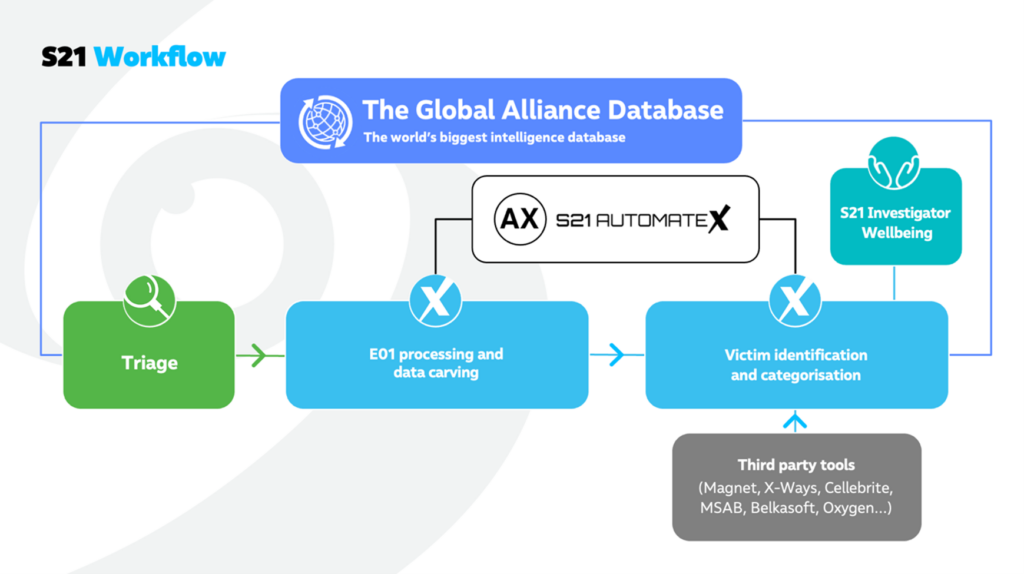
We’re proud to support and work alongside all of the tools in your digital forensics toolkit, because history has shown us that one-tool solutions don’t work and cost lives. Only by creating an open community and through collaboration can we together offer experts like yourselves the best support possible.

We’re proud to support digital forensics professionals around the world – but we want to do more. If you’re involved in CSAM investigations, CCTV review, or transcription, we invite you to get in touch for a complimentary licence to try any of our tools. Training is included, and our dedicated support team will make sure you get the most out of the experience.

We’ll smash any like-for-like quote and never hit you with expensive annual price rises. What you see is what you get – powerful, reliable, investigator-driven software that just works.
We’ve spent years developing software to meet your needs. Now it’s your turn to see the difference for yourself.
Visit www.semantics21.com, watch our webinars, or email info@semantics21.com to request your complimentary licence today.
Let’s rescue more victims. Let’s close more cases. Let’s protect those who protect us.
by Paul Gullon-Scott BSc MA MSc MSc FMBPSS
Following the release of the article my wife and I published via Forensic Focus on January 16, 2025, titled When The Job Comes Home: The Personal Toll Of Digital Forensics, a serving digital forensic investigator reached out to me and took the brave step of sharing their story. Their goal was to add their voice to the growing call for improved mental health support for DFIs. This is what they told me.
This investigator has spent a decade uncovering crucial evidence in some of the most disturbing and high-profile criminal cases. Their role has been central in bringing abusers, murderers, and cybercriminals to justice, ensuring that victims receive the closure they deserve. But while forensic investigators work behind the scenes, their exposure to graphic evidence, distressing materials, and traumatic case details leaves lasting scars.
Unlike frontline officers, digital forensic investigators are often overlooked in terms of psychological support. When support is available, it is typically reactive rather than preventative, often arriving too late—after cracks have already begun to show. This delay frequently results in time away from work, adding to the workload of the remaining team, who are acutely aware of the strain and may experience feelings of guilt.
There is an assumption that because they are not physically present at crime scenes, they are somehow shielded from the emotional and mental burden. Some senior supervisors also mistakenly believe that AI tools, such as child abuse image databases, process all recovered images, reducing human exposure. However, the reality is very different. The horrors they witness are no less real simply because they appear on a screen.
Unlike frontline officers, digital forensic investigators are exposed daily to the darkest depths of human depravity. This story is a testament to the hidden cost of justice, exposing the flaws in a system that should be protecting those who uncover the truth.
This investigator’s journey into digital forensics began with a love for technology and problem-solving. After completing three years of IT studies, they started a career in corporate e-discovery, focusing on fraud investigations and data analysis. However, corporate work lacked the sense of purpose they were looking for. They wanted to contribute to criminal investigations, applying their skills to cases that made a real difference in society.
The opportunity came when they joined the private sector, working for a company providing forensic services for law enforcement agencies, including the National Crime Agency (NCA). It was a significant step up—they would now be working on criminal cases, dealing with offenders, victims, and the full weight of the justice system.
Their first introduction to the world of child exploitation material (CSAM) was not through training or a carefully managed induction; it was in a job interview. A hiring manager, a former police officer, placed a laptop in front of them and opened explicit images of child abuse, watching their reaction closely. “It was a test to see if I could handle what the job entailed.”
At the time, the investigator was shocked but said nothing. They wanted the job and understood that their reaction could determine whether they were hired. They pushed down their discomfort, determined to prove they were capable. Years later, they would look back and recognize how damaging that moment had been—not just for them, but for many investigators hired under the same circumstances.
Over the years, they worked on hundreds of cases, each leaving its mark. Some, however, never faded. One of the first major cases they dealt with involved recovering dashcam footage from a car involved in a murder. The video captured every second of the attack—the victim greeting their killer, the conversation turning dark, and then the sound of stabbing. Over 40 wounds were inflicted in a brutal frenzy. The investigator watched and listened as the victim screamed, begged for their life, and eventually fell silent.
As time passed, their ability to compartmentalise the horrors they encountered at work started to break down. The images, sounds, and experiences began invading their everyday life. Visiting or driving past certain locations became unbearable. They could no longer take their children to a particular beach, after uncovering a case where an offender had set up a tent there to commit horrific crimes. Driving past certain houses triggered feelings of rage, knowing that individuals who had committed unspeakable acts had once lived there or were still living there.
But the worst experiences came at night. They endured vivid, distressing flashbacks, often triggered by everyday occurrences—a sound, a phrase, or even a fleeting thought. These moments pulled them back into the evidence they had examined, forcing them to relive what they had seen.
Their nightmares were even more visceral. They often dreamt of being present at crime scenes, witnessing the abuse unfold yet powerless to stop it. The frustration and helplessness they felt during waking hours carried over into sleep, triggering violent reactions. Their partner described how they struck out in their sleep, as if battling an invisible enemy. In these dreams, they weren’t just watching—they were intervening. They recalled dreams where they physically attacked offenders, beating them until they could no longer harm their victims.
These episodes of striking out in sleep have become a significant concern, not just for their own well-being but also for their family. Severe night sweats, restless leg syndrome, and occasional sleep paralysis—where they felt trapped in their own body, unable to move as terrifying visions played out—became increasingly common.
Despite the severity of their symptoms, mental health support in their workplace is nearly nonexistent. Officially, staff receive an annual mental health questionnaire, but the unwritten rule is to downplay any struggles. Those who acknowledge difficulties often face stigma, treated as if they are no longer fit for the job.
They also found that the psychological assessments used to gauge well-being fail to account for neurodiverse individuals, despite digital forensics being a field that attracts those with ADHD, autism, and other neurodivergent traits. The tools in place to measure distress are outdated, often failing to capture the unique ways that forensic investigators process trauma.
“From the outside, people assume that working in digital forensics means sitting at a desk all day, clicking through files, running scripts, and writing reports. They don’t see the mental scars, the erosion of self-worth, or the moral injury of being exposed to humanity’s worst atrocities with no real outlet for relief.
“You sit at a computer all day and then go home. But it’s not just that. Our minds don’t just switch off.”
The weight of the job, compounded by personal struggles, left them searching for an exit. They considered leaving or switching careers, but the options weren’t straightforward. Their expertise lay in a field few could handle, yet those who did received little recognition for their sacrifices. This investigator’s story is not unique—it reflects the reality of many in their field. Unseen warriors fighting battles no one acknowledges, suffering wounds no one can see or is willing to treat. Until real support structures are in place and the stigma is dismantled, the cycle will persist.
For now, they endure day by day, resisting the urge to give up, clinging to the reasons to stay. But they know that something must change—otherwise, one day, there may be nothing left to fight for.
This investigator’s story is more than a personal struggle—it is a reflection of a broken system, one that demands the impossible from those who tirelessly uncover the darkest truths yet offers little in return. These individuals stand on the frontlines of justice, unseen and unrecognized, carrying the weight of humanity’s worst atrocities. And yet, when they need help, they are too often met with silence.
But silence is no longer an option.
The mental and emotional toll on digital forensic investigators is undeniable, yet current support structures continue to fail them. A reactive approach is not enough—proactive, preventative care must be in place before the cracks begin to show. The stigma surrounding mental health in this field must be dismantled, ensuring that those who suffer never have to choose between their well-being and their career.
To those in positions of leadership: Listen! Acknowledge! & Act! Recognise the sacrifices made by these investigators and ensure they are no longer left to battle alone. Change is long overdue, and without it, we risk losing highly skilled, conscientious investigators who dedicate their lives to justice.
To the investigators still carrying this burden: You are not invisible. Your pain is real, and your struggles are valid. You are not weak for needing help, and you are not alone. Together, your voices are growing louder, demanding the support you deserve.
The question now is who will listen? And more importantly, who will act before it’s too late?
Paul Gullon-Scott BSc MA MSc MSc FMBPSS is a former Digital Forensic Investigator with nearly 30 years of service at Northumbria Police in the UK, specializing in child abuse cases. As a recognized expert on the mental health impacts of digital forensic work, Paul now works as a Higher Assistant Psychologist at Roseberry Park Hospital in Middlesbrough and is the developer of a pioneering well-being framework to support digital forensics investigators facing job-related stress. He recently published the research paper “UK-based Digital Forensic Investigators and the Impact of Exposure to Traumatic Material” and has chosen to collaborate with Forensic Focus in order to raise awareness of the mental health effects associated with digital forensics. Paul can be contacted in confidence via LinkedIn.
by Paul Gullon-Scott BSc MA MSc MSc FMBPSS
Digital forensic investigators (DFIs) are routinely exposed to traumatic material, such as child sexual abuse material (CSAM), in their line of work. This exposure places them at significant risk for secondary traumatic stress (STS), burnout, and post-traumatic stress disorder (PTSD). Recent lawsuits by content moderators against global corporations highlight the consequences of failing to provide adequate mental health support for employees exposed to distressing material. This article examines the potential impact on employers if they fail to provide adequate support, including possible litigation. It also highlights key challenges and offers actionable recommendations to mitigate risks.
Digital forensic investigators play a crucial role in identifying and prosecuting crimes involving traumatic digital content, including CSAM. The psychological toll of this work has been well-documented, with research showing increased risks of post-traumatic stress disorder (PTSD) and compassion fatigue among these professionals.
Recent legal actions by content moderators have brought attention to the ramifications of neglecting employee mental health in similar roles, underscoring the importance of organisational responsibility.
Employers of digital forensic investigators (DFIs) must recognise the parallels between content moderation and digital forensics, as both professions involve prolonged exposure to traumatic, graphic, and distressing content. Without adequate mental health support, organisations risk significant consequences, including legal liability, reputational damage, and operational inefficiencies.
For example, Facebook’s $52 million settlement addressed claims from content moderators who developed mental health conditions, such as post-traumatic stress disorder (PTSD), due to repeated exposure to disturbing material. Similarly, lawsuits filed by content moderators in Kenya highlighted poor working conditions and inadequate psychological support, drawing global attention to the importance of employee welfare in such roles.
These risks are not limited to social media companies. Law enforcement agencies and private firms employing DFIs have also faced challenges due to insufficient mental health resources. A notable example is the increasing burnout among forensic investigators tasked with analysing evidence in criminal cases involving child exploitation or violent crimes.
Many investigators grapple with moral injury, a profound sense of helplessness or guilt, especially in cases where their efforts fail to deliver justice for victims. Compounding these challenges, individuals performing dual roles, such as paedophile online investigators (POLIT) and forensic examiners, face even higher levels of psychological distress and lower job satisfaction compared to those focused on a single role.
Without mental health programmes or counselling services, such employees are more likely to experience decreased productivity, higher absenteeism, and even resignations, further straining organisational resources. Additionally, failure to address these concerns can damage an organisation’s reputation, as the public becomes increasingly aware of workplace mental health issues.
Organisations prioritising the well-being of DFIs can not only mitigate these risks but also foster a more supportive and sustainable work environment, ultimately improving both employee satisfaction and overall operational performance.
Employers who fail to address the mental health needs of digital forensic investigators (DFIs) face serious legal, financial, and operational risks. Lawsuits over inadequate mental health support—such as those filed against Facebook and the UK Ministry of Defence—have resulted in substantial settlements.
Beyond legal liability, organizations may face regulatory fines for failing to meet occupational health and safety standards. In the UK, the Health and Safety Executive (HSE) enforces these regulations and has the authority to impose unlimited fines. The Health and Safety (Offences) Act 2008 expanded penalties, while the Sentencing Council’s 2016 guidelines led to a sharp rise in fines—from £18 million in 2014/15 to nearly £70 million in 2016/17.
Neglecting mental health support also impacts workforce stability. Burnout and PTSD drive experienced DFIs to leave, forcing organizations to recruit and train replacements—a costly and time-consuming process. Meanwhile, remaining staff face heavier workloads, compounding stress and reducing productivity. Workplace stigma further erodes morale, creating a cycle of attrition and operational strain.
To mitigate these risks, employers should implement a comprehensive set of mental health interventions. These interventions should span multiple organizational levels and address both prevention and support:
The psychological challenges faced by DFIs are deeply significant and align closely with those encountered by content moderators. It is essential for employers to recognise their moral, legal, and operational responsibility to address these challenges with care and foresight.
By prioritising the implementation of robust mental health support systems, nurturing a culture of empathy and well-being, and leveraging innovative technological solutions, organisations can safeguard their workforce while fostering a healthy, supportive environment. These efforts not only protect employees but also help reduce potential legal and reputational risks.
The recent lawsuits against global corporations serve as a stark reminder of the consequences of inaction. For employers of DFIs, the path forward lies in prioritising employee well-being, ensuring ethical practices, and building resilient organisational structures.
Paul Gullon-Scott BSc MA MSc MSc FMBPSS is a former Digital Forensic Investigator with nearly 30 years of service at Northumbria Police in the UK, specializing in child abuse cases. As a recognized expert on the mental health impacts of digital forensic work, Paul now works as a Higher Assistant Psychologist at Roseberry Park Hospital in Middlesbrough and is the developer of a pioneering well-being framework to support digital forensics investigators facing job-related stress. He recently published the research paper “UK-based Digital Forensic Investigators and the Impact of Exposure to Traumatic Material” and has chosen to collaborate with Forensic Focus in order to raise awareness of the mental health effects associated with digital forensics. Paul can be contacted in confidence via LinkedIn.
by Paul Gullon-Scott BSc MA MSc MSc FMBPSS and Fiona
Throughout my 30 years of service in policing, I was committed to protecting and serving others, but the most challenging chapter of my career came during the 14 years I worked as a Digital Forensic Investigator. Those years placed me at the forefront of confronting some of the darkest aspects of humanity, as I sifted through countless traumatic images and videos documenting the abuse of innocent children. It was work I felt compelled to do, knowing that every piece of evidence could safeguard a child or bring justice to a victim. But the relentless exposure to such horrors took a heavy toll on my mental health and overall well-being.
On reflection, when I found myself at my lowest, I knew I wasn’t the only one affected by my struggles. My family, especially my wife and children, and some very close friends bore the weight of those years alongside me. One of the most under researched areas is the vicarious effect of our role on our families and friends. I asked my wife Fiona to write down the effect it had on my family.

This article, written by her, is my own story and aims to give a voice to the experiences of those who stand by us during our most difficult and dark moments. It’s a deeply personal reflection on the impact that these roles can have not only on those who do the work but on the loved ones who support us.
I asked her to write this because I want to shine a light on the unseen effects of such work on our family and friends and to advocate for better mental health support for those who walk this difficult path. Her words are a testament to the strength, resilience, and compassion of the families and friends who endure so much, and to the need for real change in how we care for those on the front lines of these traumatic professions.
I write this as the wife of a Digital Forensic Investigator who ‘broke’ under the pressures of the job, but who thankfully, through the right support and intensive specialist therapy, came out the other side. I was asked to do this to give voice to the families, and whilst this is of course a hugely personal experience and everyone will be different, I have no doubt people will relate to some of what I write.
My husband was always someone who believed that strength came from containing emotions and shielding the family from the horrors he saw daily at work. He strove to compartmentalise his day job from his home life, never speaking about what he had dealt with or seen at work, pushing that deep inside. ‘Support’ at work was a once yearly 10-minute chat with Occupational Health, after which they wrote a couple of sentences stating he was fit to work. I knew different though. When I would try to talk to him, ask what was wrong or offer an ear, he would deny any problem, saying: “It’s nothing” or “Doesn’t matter”, and shut down any conversation. But it was obvious things were not OK. He was becoming more and more irritable, less able to sleep, spent more time in his own thoughts, increasingly built a ‘wall’ around himself that I could not penetrate, and pushed me away. He started smoking more and more, frequently snacking late at night yet failing to finish a single decent meal, losing weight and looking gaunt and haggard. With friends or wider family he would put on an act of joviality, of ‘normal’, but even that started to slip, and people who had never seen him anything other than caring, kind, interested, and full of enthusiasm for life, started to see more and more frequent glimpses of negativity, grouchiness, and disengagement.
I watched as he started to drink more each weekend, to the point that alcohol was a means to knock himself out in order to sleep (I learned this fact later – at the time, all I saw was a husband getting blind drunk almost every weekend without fail). I cycled between feeling concerned for him and his health, through feeling angry that he was drinking to the point he couldn’t walk straight then lurching off to bed leaving me alone downstairs, to feeling pity for this man who was always so strong and now seemed broken and beaten. I don’t think he ever knew I felt pity; I think it would have broken him further to have known that.
When he was drunk, whatever walls he was trying to build to contain the horrors would weaken, and it would all come out. It came out in various ways. Sometimes he would break down and cry uncontrollably, voicing things I could not understand and speaking of ‘the pink baby’ through wracking sobs and heaving gasps for air. Sometimes he got angry, was short tempered with me and our children, snapping and barking at the smallest comments or actions. At worst he would throw things, slam doors, storm out. Sometimes in his sleep he would flail around or lash out, punching or kicking me without realising as he battled the demons in his head.
Paranoia started to creep in, and he would make remarks suggesting I didn’t love him, that I thought he wasn’t good enough, that I wanted someone else – all his own thoughts of himself being reflected outwards. His mood was constantly low and negative, so the ‘norm’ became a kind of constant silence interspersed with occasional superficial chat, and as a family we dreaded the weekends, tiptoeing around so as not to trigger any outburst. I would try and excuse or explain any upset to minimise the impact on the kids, but they started to retreat from him and hide away in their rooms at those times, often sending me messages seeking reassurance or needing to talk to me through their fear that something bad would happen. I wrestled with my love for him and my own sense of self, hating myself for starting to wonder if I should leave for my sake and our children’s, never wanting to but crying alone at night at the thought that I may have no choice. I was determined not to let go of who I knew him to truly be, but it was incredibly hard at times.
On several occasions, the horrors he tried to keep away from the home came out, and in his drunkenness he would tell me things he had had to watch and listen to at work. Things he – in sober daytime – insisted he would never share because they were just too awful, describing the sounds, the screams, the images. He never remembered the next day that he had done this, nor did he remember the times he kicked or punched me in his sleep, or accused me of wanting to leave him, or any of the other things that spilled out of his mind from that place of darkness.
At one of his lowest points, after we had argued over nothing, he stormed out of the house in such a state of distress and turmoil I was intensely worried for him. He had turned off his ‘find my friends’, ignored all my calls, and I had no idea where he was or what he was doing. In desperation, I rang one of his best friends, who called him and managed to get through and was able to reassure me he was just getting some headspace. I recently found out he had in fact driven to a local bridge and was contemplating taking his life. Whatever it was that stopped him from doing so, I am eternally grateful.

I and friends tried many times to speak with him and voice our concerns, but these were frequently dismissed. He would diligently go in to work day after day, arguing that if he didn’t do so, then who would save the children being abused? Day after day he would come home a shell of who he used to be. Then finally one day – after months of low mood, drinking, weight loss, poor sleep and other signs of depression and trauma – he conceded that he needed help. I could see the immense effort it took for him to acknowledge that. I could see he thought it made him weak, that he wasn’t being a man. I could see his self-esteem was on the floor; he was utterly broken. We did all we could to communicate that the decision showed strength not weakness, that we were all so proud of him, but all he could think was that he was letting people down, he was letting the children down, he had failed. With much persuasion, love, and encouragement he went to the GP and was signed off from work on long-term sick leave.
Initially he was sent to a counsellor through the Employee Assist Programme. That was, quite frankly, utterly useless. They didn’t have the skillset to deal with the things he was carrying. However, we are lucky that through my work I could source someone qualified in trauma, even though it meant we paid privately, and I am ever grateful to her, and to my husband for attending that first appointment with her. I would pay privately again in a heartbeat to bring the right support to someone I love. It took 13 months of specialist trauma therapy, but the difference was immense. I got my husband back; he was lighter in spirit; he could smile and laugh again.
I look back on those times, the months of darkness and pain, for my husband and for us as a family, and remember the times I nearly walked away. Had my husband not taken the unbelievably brave step to seek help when he did, we may not have survived. I am ever grateful to him for being the man I always knew him to be, for facing his demons and staying with the trauma therapy, for not letting PTSD break him. It so easily could have been different.
Now, several years on, his lived experience not only in the DFI job but of what that job can do to a person, coupled with his sheer determination to help change things so that other DFIs do not have to go through these stressors alone, to raise awareness of the very real risks for vicarious trauma, and to improve mental health and wellbeing support for DFIs, has made him a leading light in the field. I am supremely proud of him and all he does, and I hope that when he reflects on those dark times he can see his strength and the eternal love I and our family have for him.
The PTSD, the darkness, still sits in there, and every now and then it emerges momentarily. I don’t think it will ever go away. He can never unsee or unhear the things he had to deal with over the years, and quite frankly I cannot even begin to imagine how incredibly horrific that must be. Thankfully though, he now knows it for what it is, and knows how to respond to it in a healthy and constructive way. I am behind him 100% as he strives to bring this positivity to fellow DFI’s.
Knowing the toll my work has taken on my family is one of the most difficult truths I’ve had to face. For 14 years as a Digital Forensic Investigator, I was exposed to the worst of humanity, hundreds of thousands of images and videos showing the abuse of children and other horrors. It was work I felt compelled to do, believing it was my responsibility to protect the vulnerable and seek justice. But I failed to see how the horrors of my job were not only eroding my own mental health but were also devastating the people I love most: my wife, our children, my wider family and good friends. I failed to see how I was failing those I love.
Looking back, I see the pain my silence and emotional withdrawal caused. I believed I was shielding them by bottling everything up and carrying the burden alone, but in reality, it created walls that pushed them away. My struggles manifested in ways that hurt them – irritability, emotional distance, and behaviours that I am deeply ashamed of. It breaks my heart to know they had to tiptoe around me, fearing my outbursts or silence.
My wife’s strength and compassion carried us through those dark times. She stood by me, even when I know she questioned whether she could endure it. Her love and resilience are the reasons I eventually found the courage to seek help. I cannot explain how difficult it was for me to look her in the eye and say: “I can’t do this anymore, I’m done”. Her reaction was one of immense relief and love. I will forever regret the pain I caused her and our children, and I am profoundly grateful for their patience, love, and unwavering belief in me.
This realisation is why I asked my wife to write about our journey from her perspective. I want her voice to be heard because it represents the silent struggles of so many families affected by the unspoken traumas of roles like mine. Her perspective sheds light on the vicarious toll this work takes on our loved ones and reinforces the urgent need for better mental health support, not just for professionals but also for the families who support us.
As Fiona points out, I will never be able to unsee what I’ve been exposed to, but as I continue to heal and now spend many hours working to raise awareness about these challenges, I carry a deep sense of responsibility to those who might still be suffering in silence. If sharing our story can help even one family feel less alone or one person seek the help they need, then it is a step towards making amends for what my family endured. I will always be grateful for their love and forgiveness, and to my very good friend who rang me that day and simply talked to me. I now strive every day to ensure I honour my wife, children, wider family and close friends by being the husband, father, uncle, brother and friend they deserve and know me to be. I dedicate this article to my own wife and children and the families of DFIs who are enduring similar experiences. Your resilience and strength are inspiring. Don’t give up on your hero; your unwavering support can make all the difference in their journey.

If anyone out there reads this story and feels inspired to share their own journey, please don’t hesitate to reach out to me at paul.gullon-scott@forensicfocus.com. Your story matters, and by sharing it, you may not only help others but also find the process to be deeply cathartic and healing. Together, we can foster understanding, support, and a sense of community in this challenging yet vital field.
I’ll leave you with something I have learned on my journey:
“Even in the darkest chapters, the decision to ask for help is a powerful act of bravery and self-respect not weakness. Healing is not a solitary journey; it’s a collective effort built on love, compassion, and understanding.”
Paul Gullon-Scott BSc MA MSc MSc FMBPSS is a former Digital Forensic Investigator with nearly 30 years of service at Northumbria Police in the UK, specializing in child abuse cases. As a recognized expert on the mental health impacts of digital forensic work, Paul now works as a Higher Assistant Psychologist at Roseberry Park Hospital in Middlesbrough and is the developer of a pioneering well-being framework to support digital forensics investigators facing job-related stress. He recently published the research paper “UK-based Digital Forensic Investigators and the Impact of Exposure to Traumatic Material” and has chosen to collaborate with Forensic Focus in order to raise awareness of the mental health effects associated with digital forensics. Paul can be contacted in confidence via LinkedIn.
Artificial Intelligence (AI) is no longer a distant future technology but an integral force driving change across multiple industries, including the legal sector. Specifically, AI is revolutionizing the practice of eDiscovery, where legal professionals face the daunting task of managing vast quantities of electronically stored information (ESI). As data continues to grow at an exponential rate, AI has emerged as an essential tool in making eDiscovery more efficient, cost-effective and accurate.
This article delves deeper into the significant ways AI is reshaping eDiscovery processes, with a focus on recent developments, key technologies like machine learning, natural language processing (NLP), predictive coding and ethical considerations in AI’s legal applications. We will also explore the practical implementation of these technologies and discuss the evolving future of AI in legal discovery.
Document review has historically been one of the most labor-intensive and expensive phases of eDiscovery, often requiring large teams of legal professionals to sift through millions of documents in search of relevant information. With such a high volume of data, the risk of human error and oversight can be significant. AI is reshaping this aspect of eDiscovery by automating large portions of the review process and increasing both speed and accuracy.
Machine Learning and Predictive Coding: Predictive coding, a subset of machine learning, has become one of the most transformative AI technologies in eDiscovery. It allows legal teams to train a machine learning model to recognize patterns in data—specifically, to categorize documents based on relevance. Legal professionals mark a sample set of documents (typically a small portion of the dataset) as relevant or irrelevant, and the AI system uses this data to “learn” and categorize new documents.
Predictive coding is highly effective in reducing the volume of documents that require manual review. It allows legal teams to prioritize the most relevant documents, significantly shortening the time required for document review and reducing associated costs. The AI model continually refines itself as more documents are reviewed, a process known as continuous active learning (CAL), ensuring increasing accuracy throughout the review process.
The adoption of predictive coding gained momentum following the Da Silva Moore v. Publicis Groupe case, which marked a pivotal moment by being the first federal case to formally approve the use of this technology for discovery.
In this case, predictive coding was employed to sift through over three million emails, achieving an impressive 86% accuracy rate in identifying relevant documents. This drastically reduced the time and expenses typically involved in manual document review, showcasing the technology’s effectiveness in streamlining eDiscovery processes.
Recent Development: Companies like Relativity have integrated predictive coding into their platforms, providing legal teams with powerful tools to scale up eDiscovery reviews. These platforms offer features like CAL, enabling the system to update categorization models based on ongoing review, improving efficiency and accuracy in real time.
Natural Language Processing (NLP) is an AI technology that enables machines to understand and process human language. NLP is having a profound impact on eDiscovery by enabling legal teams to extract meaningful insights from vast amounts of unstructured data, such as emails, contracts or social media communications.
Entity Recognition and Sentiment Analysis: NLP tools can identify key entities—people, organizations, dates and locations—in large document sets. This capability is invaluable in helping legal teams focus their efforts on critical documents and ensure they do not miss key information. Additionally, sentiment analysis powered by NLP helps legal professionals understand the tone of communication, which can be crucial in cases involving defamation, fraud or other emotionally charged disputes.
Document Summarization: NLP is also being used to generate concise summaries of lengthy documents, reducing the need for manual reading and allowing legal teams to focus on key points. By scanning through large datasets, AI models can identify relevant clauses, terms or references in contracts, speeding up review cycles significantly.
Example: Dentons has developed an AI platform for contract automation that incorporates NLP to interpret and automate contracts within the Contract Express system. This technology enables the AI to understand and process contract language, reducing the time needed for automation. The platform is designed to be user-friendly, allowing lawyers with minimal technical expertise to automate contracts efficiently. The use of NLP is central to the platform’s ability to work with various languages and streamline the contract drafting process.
As the volume of data continues to expand, traditional methods of handling eDiscovery become increasingly unsustainable. AI’s ability to scale up processing capacity without increasing the need for human resources makes it an indispensable tool for law firms and in-house legal departments dealing with high volumes of data.
Automating Routine Tasks: Legal teams can automate tasks that would traditionally take hundreds of hours of human labor, such as document classification, keyword searches, and data extraction. By automating these processes, AI allows legal teams to allocate their time and resources toward higher-value tasks, such as formulating legal strategy, client engagement and expert consultation.
Cost Efficiency: In terms of cost savings, AI-powered solutions have proven to be highly effective. By reducing the amount of time required for manual document review, AI can reduce costs associated with hourly billing, freeing up resources for more strategic legal work. For example, using AI to handle the initial review phase allows firms to pass on the cost savings to clients, making their services more competitive.
Example from the Field: JP Morgan Chase has transformed its contract analysis process with the introduction of its AI-powered system, COIN (Contract Intelligence). This technology uses natural language processing (NLP) and machine learning to swiftly analyze complex financial documents, drastically reducing the time and costs associated with manual reviews. COIN enhances accuracy, consistency and scalability, while helping the bank ensure compliance, manage risks and improve customer service. By automating the analysis of contracts, JP Morgan Chase has set new industry standards for efficiency and precision, underscoring the pivotal role of AI in reshaping financial services.
As AI continues to reshape the legal landscape, it brings with it a host of ethical and regulatory challenges. The deployment of AI in eDiscovery raises critical questions about transparency, bias and compliance.
Mitigating Bias: One of the key ethical issues with AI tools in eDiscovery is the potential for algorithmic bias. AI models are only as unbiased as the data they are trained on, and if historical datasets contain biases, AI can unintentionally perpetuate them. In legal contexts, this can result in unjust outcomes, such as biased document classification or the exclusion of relevant information.
Regulatory Compliance: As AI tools handle increasingly sensitive data, compliance with legal standards—such as the General Data Protection Regulation (GDPR) in Europe and the California Consumer Privacy Act (CCPA) in the U.S.—becomes a significant concern. Legal teams must ensure that AI tools respect privacy laws and adequately protect sensitive information during eDiscovery.
Transparency and Accountability: Ensuring transparency in AI-driven decision-making is vital, especially when AI tools are involved in legal proceedings. Legal professionals must understand how AI systems make their decisions to provide accountability and ensure the accuracy of the results.
As AI technology continues to evolve, its potential applications in eDiscovery are only expanding. We are seeing the development of more advanced AI tools that not only support predictive coding and document review but also provide deeper insights into case strategy, legal research and even predictive analytics for trial outcomes.
Generative AI and eDiscovery: The rise of generative AI technologies, such as GPT-based models, is opening new frontiers in legal discovery. These systems are capable of generating human-like summaries of documents, suggesting case strategies and even providing automated legal research. As these tools become more refined, they will further revolutionize the way legal teams approach eDiscovery.
Integration with Legal Analytics: AI is also increasingly integrated with legal analytics tools, enabling legal professionals to predict case outcomes based on historical data. This integration will empower legal teams to make more informed decisions, predict the trajectory of litigation and optimize case strategies based on data-driven insights.
AI is undeniably transforming the eDiscovery process, offering significant improvements in efficiency, accuracy and cost-effectiveness. With its ability to automate document review, process vast datasets and extract actionable insights from unstructured information, AI is helping legal professionals tackle the growing complexities of modern litigation.
As AI tools continue to advance, the legal industry must address important ethical, compliance and transparency issues to ensure that AI is used responsibly and effectively. By embracing these technologies, law firms and legal departments can not only streamline their eDiscovery processes but also gain a competitive edge in an increasingly data-driven legal landscape.
The future of AI in eDiscovery promises even greater innovation and efficiency, from predictive analytics to advanced legal research. For legal professionals looking to stay ahead of the curve, understanding and adopting AI-driven solutions will be essential for navigating the challenges and opportunities of tomorrow’s legal world.
In a world that’s evolving rapidly, Cellebrite Enterprise Solutions looks beyond the horizon to design solutions to keep data within reach, transform it and reveal important insights to protect your business and employees. From headquarters to home office, e-discovery professionals and corporate investigators can access endpoints anywhere with Cellebrite’s enterprise solution offerings.
Here’s a look back at the significant remote collection capabilities and enhancements that Oxygen Forensics added to Oxygen Remote Explorer in 2024.
The ability to reduce costs and streamline investigations using remote collection are key benefits provided by Oxygen Remote Explorer.
In 2024, Oxygen Forensics enhanced remote data collection from Windows-based endpoints.
First, Oxygen Forensics added the ability to remotely capture a Windows OS memory dump. Now users can right-click the endpoint of interest and select the option to create a memory dump. The created dump is sent to the server. Users can then download the dump from the server and use a third-party tool for its analysis.
Second, Oxygen Forensics introduced the ability to remotely capture a bit-by-bit Windows OS disk or disk partition image in E01 format. Now investigators can create dumps both for unencrypted disks and partitions and for those protected with Bitlocker. The created dump can be saved to local storage or sent to the server.
Finally, Oxygen Forensics implemented deleted file recovery from remote endpoints for NTFS, FAT, and exFAT file systems.
In 2024, Oxygen Forensics added new features that make Oxygen Remote Explorer a more powerful tool for remote data collection from Android and Apple iOS devices.
Oxygen Forensics dramatically improved the remote iOS extraction algorithm to allow for selective data extraction. Now investigators can choose to extract only specific artifacts to comply with their search requirements. This change also helps to alleviate server load and speed up collection and transfer of extracted data for analysis.
Oxygen Forensics also added the ability to collect WhatsApp and WhatsApp Business data remotely from anywhere in the world with cellular or Wi-Fi connection. This new feature allows investigators to collect a range of WhatsApp data including user info, chats, contacts and calls. Before extraction, users can fine tune the extraction options to select the data that should be obtained. WhatsApp data extraction options are highly customizable, allowing for fast and targeted data collection.
In 2024, Oxygen Forensics added a number of functionality enhancements to the Agent Management Center, including:
Users now have the capability to remotely access the endpoint file system, enabling them to select specific artifacts for extraction and import into Oxygen Remote Explorer for analysis and reporting purposes.
Finally, Oxygen Forensics added the ability to work with the endpoint file system. Now investigators can browse the file system to select the artifacts they need to extract, set paths for temporary files, or choose the local storage for disk images.
New extraction options for remote collection of WhatsApp and WhatsApp Business data from Android devices have been added, including the selection of the names of the chats and the dates.
Oxygen Forensics added the ability to automatically restart data extraction tasks that finished with errors. Users can also set the number of task retry attempts and choose to prioritize them over other extraction tasks.
Users can now download the Agent for Windows in MSI format along with the existing EXE format, providing greater flexibility for deployment.
Support has been added for additional computer artifacts, and users can now search by hash sets.
The following new computer artifacts are supported for extraction:
Oxygen Forensics added the ability to use hash sets when creating file search rules.
Our industry-best cloud extraction capabilities now include updated cloud services authorization.
Oxygen Forensics updated the ability to authorize in the following cloud services:
Several updates have been added to KeyDiver, our decryption tool for computer partitions, files, and applications.
Now KeyDiver can find passcodes to decrypt:
Oxygen Forensics also added support for NTLM hashes. This allows users to find passwords for a Windows OS user account, allowing decryption of OS data and third-party applications connected with this password.
Oxygen Forensics added the ability to create custom attack templates. Users can use two methods for creating a template:
A Settings window has been added to allow users to enable or disable drivers (CUDA, HIP, OpenCL, Temperature Monitoring), manage the attack queue, set a temperature threshold, and adjust the desired performance. The selected settings will be saved and automatically applied to all current and subsequent attacks.
Automatic detection of connected devices is now supported in Oxygen Remote Explorer. When Device Extractor is launched, the available information about a connected device will be shown along with the available methods of data extraction.
Automatic detection is supported for Android devices if ADB debugging is enabled and confirmed, and for iOS devices with the confirmed Trust option.
Several enhancements have been added to this method:
Oxygen Forensics also added support of importing and parsing of social media platform account data, including the following.
Oxygen Remote Explorer now supports the import and parsing of TikTock account data. The extracted categories include the following information:
Oxygen Forensics addressed one of its most-requested capabilities with the addition of a built-in module that allows selected scanning of extracted files for malware and potential threats. Now you can unlock advanced malware detection – including searches using YARA Rules.
Now you can also configure the malware scan settings and initiate a malware scan. Both the whole extraction file structure and only selected files can be scanned. There are more than 10 identifiable threats supported. The results will appear on the toolbar, displaying the scanned file status, identified threats, scan start time, and other relevant details.
Request a demo to experience Oxygen Remote Explorer’s capabilities.
by Paul Gullon-Scott BSc MA MSc MSc FMBPSS
Post-Traumatic Stress Disorder (PTSD) is a well-recognised mental health condition that develops after exposure to trauma. While it is typically associated with direct traumatic experiences, those who work in professions that involve repeated exposure to distressing materials or accounts, such as digital forensic investigators (DFIs), law enforcement officers, or healthcare professionals, can also develop trauma-related symptoms. In such cases, PTSD is often referred to as Secondary Traumatic Stress (STS) or Vicarious Trauma (VT). These terms reflect the unique way in which indirect exposure to trauma affects individuals. Compounding these challenges is the frequent coexistence of anxiety, which exacerbates emotional and physical strain.
In DSM-5, STS and VT are now incorporated into the PTSD diagnosis, acknowledging the broader spectrum of trauma-related conditions. This inclusion highlights the significance of addressing the cumulative effects of trauma exposure, particularly in professions like forensic investigation, policing, and healthcare, where repeated exposure to distressing material or events can lead to serious mental health challenges.
In this article, we’ll look at the relationship between PTSD and anxiety. We’ll explore their definitions, signs, and symptoms, their emotional and physical impacts, and coping mechanisms. Furthermore, this article will consider the effects on personal and professional life, examine cultural and stigma-related barriers, and propose interventions to alleviate the burden on affected individuals.
PTSD arises following exposure to trauma and is characterised by intrusive memories, avoidance behaviours, emotional detachment, and hypervigilance. For DFIs who review graphic content, symptoms can mirror those of primary trauma survivors, including nightmares, emotional dysregulation, and intrusive thoughts. Over time, untreated symptoms can shift an individual’s worldview, leading to cynicism, emotional exhaustion, and diminished trust in others. Gullon-Scott and Johnson (2024) and Kelty et al. (2021) found that 30% of DFIs exhibited clinical PTSD symptoms.
Anxiety, while distinct, is closely linked to PTSD. It manifests as persistent worry, fear, and physical symptoms like muscle tension, restlessness, and difficulty concentrating. PTSD’s heightened alertness perpetuates feelings of fear and nervousness, creating a cycle of emotional distress. Together, PTSD and anxiety pose significant challenges for professionals exposed to trauma.
Symptoms overlap significantly: flashbacks, emotional detachment, avoidance behaviours, and insomnia are hallmarks of PTSD, while anxiety introduces persistent worry, fatigue, and physical strain. Findings from the 2024 Forensic Focus Investigator Wellbeing Survey underscore how indirect trauma, such as exposure to distressing evidence, mirrors the psychological impacts of direct trauma.
PTSD and anxiety are interconnected, reinforcing each other in a feedback loop. PTSD’s hypervigilance can heighten anxiety, making it difficult for DFIs to relax and leading to chronic worry and alertness. Conversely, persistent anxiety prevents trauma processing, perpetuating PTSD symptoms and emotional exhaustion.
Emotionally, PTSD and anxiety lead to recurring feelings of dread, helplessness, and frustration. DFIs often report emotional exhaustion and difficulty maintaining empathy. Physically, symptoms include fatigue, headaches, gastrointestinal issues, and sleep disturbances, which exacerbate stress and undermine well-being. Over time, this can result in serious health conditions, such as cardiovascular issues and weakened immunity.
Unaddressed PTSD and anxiety have profound consequences. Professionally, they reduce focus, slow case progress, and increase errors. Emotional exhaustion impairs decision-making, productivity, and collaboration, leading to burnout and high turnover rates. Personally, emotional withdrawal, irritability, and avoidance of work-related discussions strain relationships, deepening feelings of isolation.
Stigma remains a major barrier to addressing PTSD and anxiety. Professionals fear judgement, professional repercussions, or perceptions of weakness, particularly in resilience-driven workplaces. Cultural norms that prioritise productivity over employee well-being exacerbate these challenges. The absence of trauma-informed policies leaves individuals unsupported and reluctant to seek help.
The Forensic Focus Investigator Well-Being Survey highlights how organisational cultures focused on outcomes often sideline mental health. This perpetuates stigma, framing mental health struggles as personal failings rather than workplace concerns. Addressing this requires cultural shifts that normalise mental health discussions and encourage seeking help as a strength.
Addressing PTSD and anxiety demands systemic and individual approaches. Organisations must implement trauma-informed policies, confidential counselling services, regular well-being assessments, and anonymous peer support platforms. Leadership training on empathy and stress management is critical to fostering supportive environments.
Practical measures, such as role rotation and limiting exposure to distressing materials, can reduce psychological strain. On an individual level, resilience training, mindfulness practices, and peer networks empower individuals to manage symptoms effectively. Healthy coping mechanisms—like exercise, journaling, and creative outlets—help process emotions and alleviate stress.
The Forensic Focus Investigator Well-Being Survey and prior research align on these solutions, advocating for leadership-driven cultural shifts and structured support systems. By prioritising mental health, organisations can protect the well-being of professionals facing the emotional demands of trauma-exposed work.
PTSD and anxiety remain significant challenges for DFIs, affecting emotional, physical, personal, and professional well-being. Organisations must address these issues through trauma-informed policies, leadership training, and practical interventions, such as role rotation and peer support systems. Normalising mental health discussions and reducing stigma are essential steps toward fostering healthier, more sustainable workplace environments.
Firstly, I would like to extend my heartfelt gratitude to all the Digital Forensic Investigators who have taken the time to contact me directly and share your experiences. Your openness and willingness to speak out cannot be overstated in its importance. Sharing your experiences not only helps to shape future research but can also serve as a cathartic outlet, allowing you to decompress and bring attention to the challenges you face. Your voices are essential in driving meaningful change and shaping future research.
To the professionals in digital forensics, your work is invaluable, and your resilience is extraordinary. However, the weight you carry is not yours alone to bear. It is imperative that organisations and society recognise the toll of your role and commit to supporting you through comprehensive, meaningful interventions. Together, we can create a healthier, more sustainable workplace, where those who dedicate their lives to justice can thrive both personally and professionally.
As the festive season approaches, I want to take a moment to express our deepest gratitude for the extraordinary work you do, often behind the scenes and away from the spotlight. While many of us will be celebrating with friends and family, you will be facing some of the darkest corners of humanity, examining traumatic material to keep us all safe.
The courage and resilience it takes to do your job, especially during this time of year, does not go unnoticed. You may not wear a uniform or stand on the front lines, but the contribution you make to justice and public safety is immeasurable. Your work protects lives, safeguards communities, and brings solace to victims and their families, even if the cost is personal sacrifice.
We at Forensic Focus wish a Merry Christmas to you and your families, who may be without you at their table during the festive period, as you dedicate yourselves to protecting and serving others. May this season bring moments of peace, love, and reflection for you and your loved ones. With the utmost respect and gratitude, we wish you strength, joy, and hope for the year ahead. Stay safe; we thank you for your service and your commitment.
With deepest thanks and warm wishes,
Paul Gullon-Scott & Forensic Focus
Paul Gullon-Scott BSc MA MSc MSc FMBPSS is a former Digital Forensic Investigator with nearly 30 years of service at Northumbria Police in the UK, specializing in child abuse cases. As a recognized expert on the mental health impacts of digital forensic work, Paul now works as a Higher Assistant Psychologist at Roseberry Park Hospital in Middlesbrough and is the developer of a pioneering well-being framework to support digital forensics investigators facing job-related stress. He recently published the research paper “UK-based Digital Forensic Investigators and the Impact of Exposure to Traumatic Material” and has chosen to collaborate with Forensic Focus in order to raise awareness of the mental health effects associated with digital forensics. Paul can be contacted in confidence via LinkedIn.
Bourke, M. L., & Craun, S. W. (2014). Secondary Traumatic Stress Among Internet Crimes Against Children Task Force Personnel. In Sexual Abuse (Vol. 26, Issue 6, pp. 586–609). https://doi.org/10.1177/1079063213509411
Burns, C. M., Morley, J., Bradshaw, R., & Domene, J. (2008). The emotional impact on and coping strategies employed by police teams investigating internet child exploitation. Traumatology, 14(2), 20–31. https://doi.org/10.1177/1534765608319082
Gullon-Scott, P. (2024, December 5). Forensic Focus Investigator Wellbeing Survey Results. Forensic Focus. https://www.forensicfocus.com/articles/forensic-focus-investigator-well-being-survey-2024-results/
Gullon-Scott, P., & Johnson, D. (2024). UK-based digital forensic investigators and the impact of exposure to traumatic material. In Journal of Criminological Research, Policy and Practice: Vol. ahead-of-print (Issue ahead-of-print). https://doi.org/10.1108/JCRPP-08-2023-0047
Kelty, S. F., McQueen, E., Pymont, C., & Green, N. (2021). Avoiding Burnout at the Digital Forensics Coalface: Targeted strategies for forensic agencies in the management of job-related stress. Forensic Science International: Digital Investigation, 38, 301127. https://doi.org/10.1016/j.fsidi.2021.301127
Perez, L. M., Jones, J., Englert, D. R., & Sachau, D. (2010). Secondary Traumatic Stress and Burnout among Law Enforcement Investigators Exposed to Disturbing Media Images. Journal of Police and Criminal Psychology, 25(2), 113–124. https://doi.org/10.1007/s11896-010-9066-7
Strickland, C., Kloess, J. A., & Larkin, M. (2023). An exploration of the personal experiences of digital forensics analysts who work with child sexual abuse material on a daily basis: “You cannot unsee the darker side of life”. In Frontiers in Psychology (Vol. 14). https://doi.org/10.3389/fpsyg.2023.1142106
Tehrani, N. (2018). Psychological well-being and workability in child abuse investigators. In Occupational Medicine (Vol. 68, Issue 3, pp. 165–170). https://doi.org/10.1093/occmed/kqy016
Wilson-Kovacs, D., Rappert, B., & Redfern, L. (2021). Dirty Work? Policing Online Indecency in Digital Forensics. In The British Journal of Criminology (Vol. 62, Issue 1, pp. 106–123). https://doi.org/10.1093/bjc/azab055
Yavuz Sercekman, M. (2024). Exploring the sustained impact of the Mindfulness-Based Stress Reduction program: A thematic analysis. Frontiers in Psychology, 15, 1347336. https://doi.org/10.3389/fpsyg.2024.1347336